Весеннее путешествие по Италии. Часть 1. Тренто > > >
Весеннее путешествие по Италии. Часть 2. Мантуя > > >
Третий день был посвящен городу Брешиа, второму по величине городу Ломбардии. От Вероны на поезде добираться около часа, по дороге проезжаем мимо очень красивого озера Гарда, там немало пассажиров сошло, но т. к. мы в свое время были на Гарде в городе Сермиоле, то проследовали дальше.
Брешиа лежит в стороне от туристских маршрутов, а зря. Брешиа известна на весь мир своей промышленностью, торговлей и сельским хозяйством. В то же время это пленительный город, богатый историческим прошлым, произведениями искусства и памятниками архитектуры, часть которых внесена в список Всемирного достояния человечества ЮНЕСКО. Это древний город, основанный еще 3200 лет назад.
Город довольно большой, есть линяя метрополитена. От вокзала зашли в инфоцентр, взяли карту и двинулись в центр города.
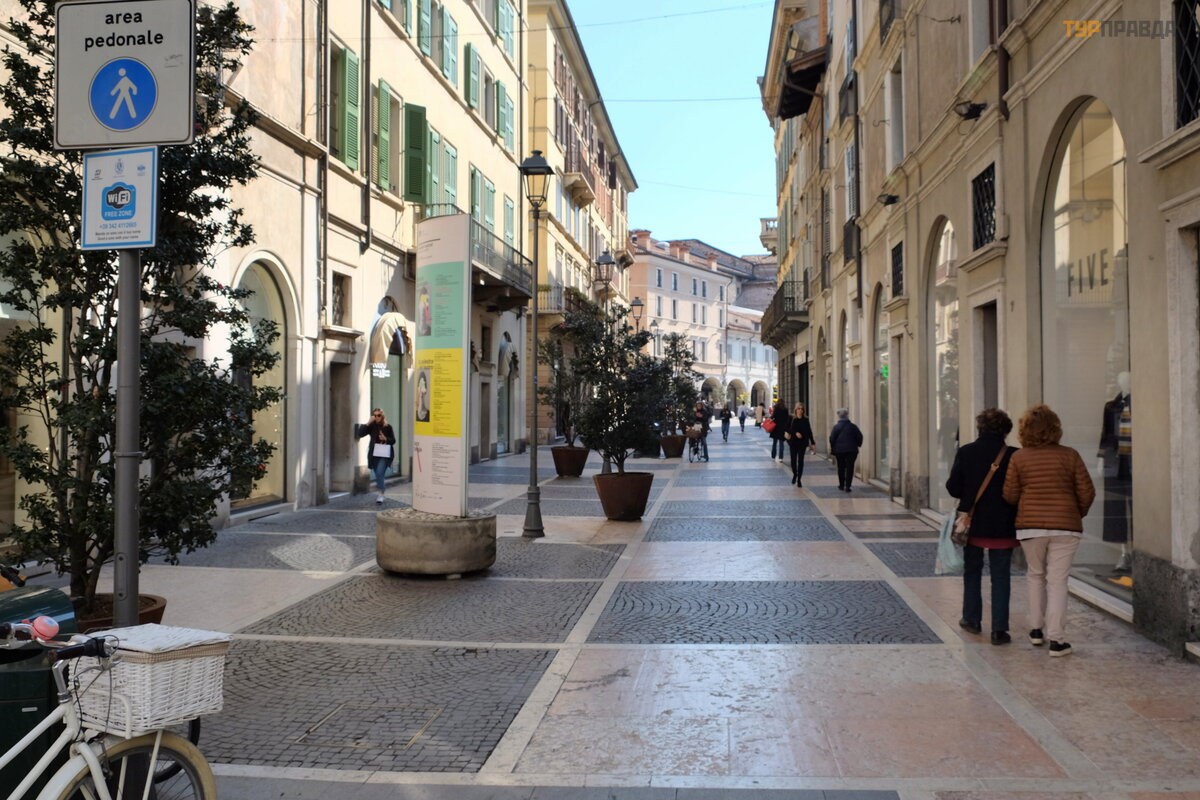
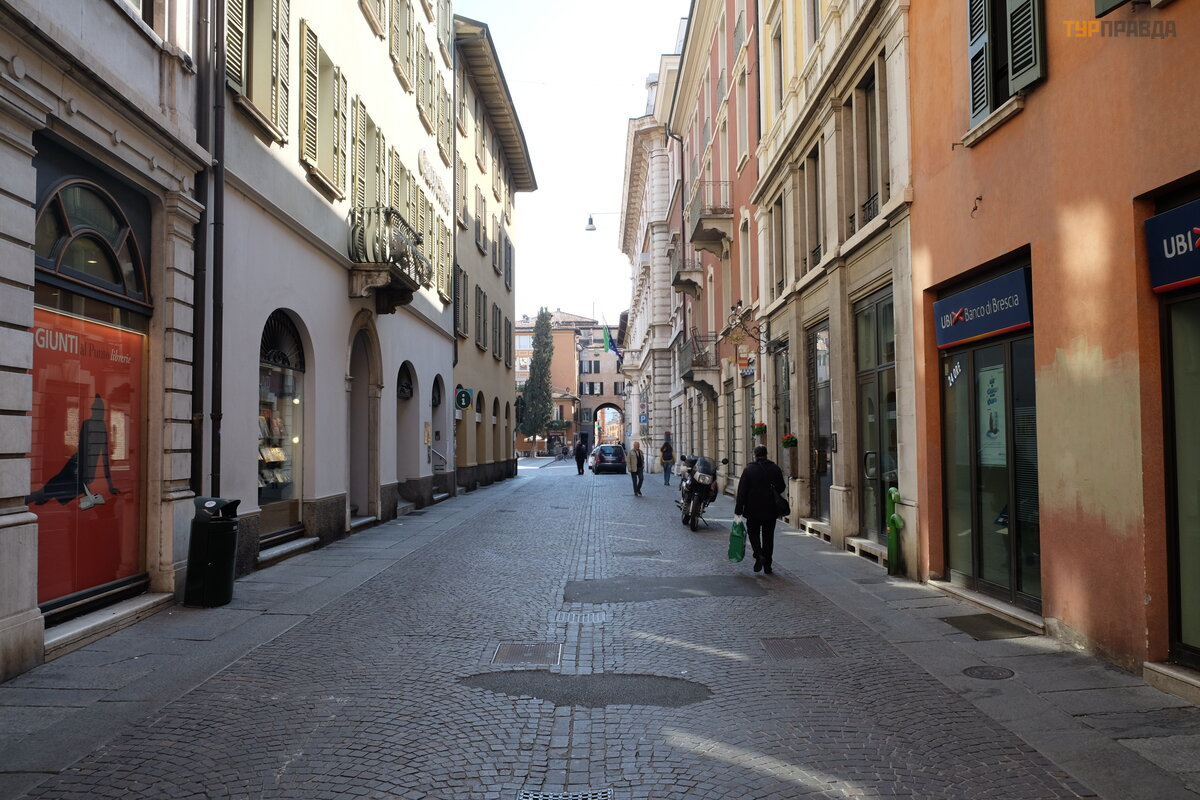
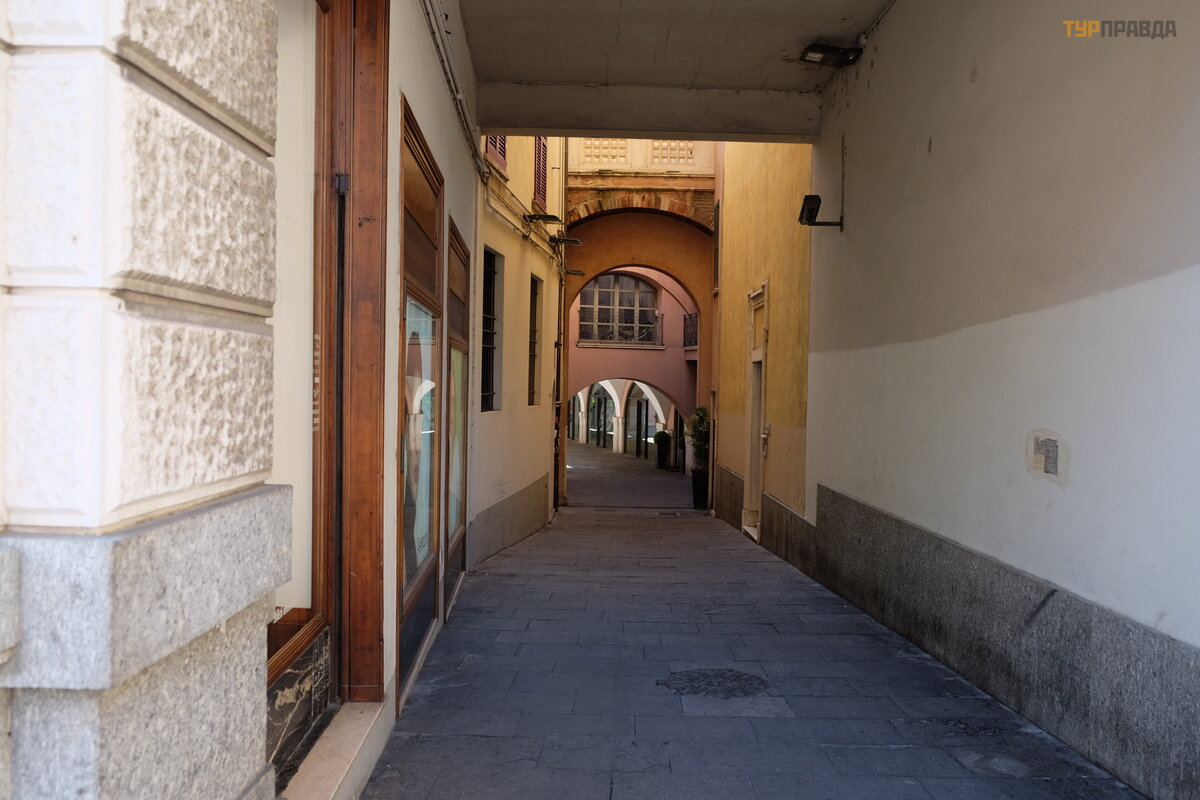
Выходим на площадь перед Кафедральным собором.
Пьяцца Дуомо – великолепная историческая площадь, которая является сердцем Брешии. Это городское пространство окружено старинными зданиями с уютными уличными кафе.
С 1963 г. площадь называется пьяцца Паоло VI. Папа римский Паоло VI, в миру – Джованни Баттиста Энрико Антонио Мария Монтини – уроженец Брешии.
Здесь расположено сразу три знаковых достопримечательности:
Новый собор – красивая церковь 17 века в стиле барокко и рококо с массивным центральным куполом, добавленным в 1825 году. Старый собор – древняя романская ротонда, которая датируется 11-12 веками. Под собором находится склеп, построенный в 9-11 столетиях как часть ещё более древней базилики. Бролетто – старая средневековая ратуша 12-го века с квадратной башней Понкарали, добавленной 100 лет спустя. Высота башни 91 метр. 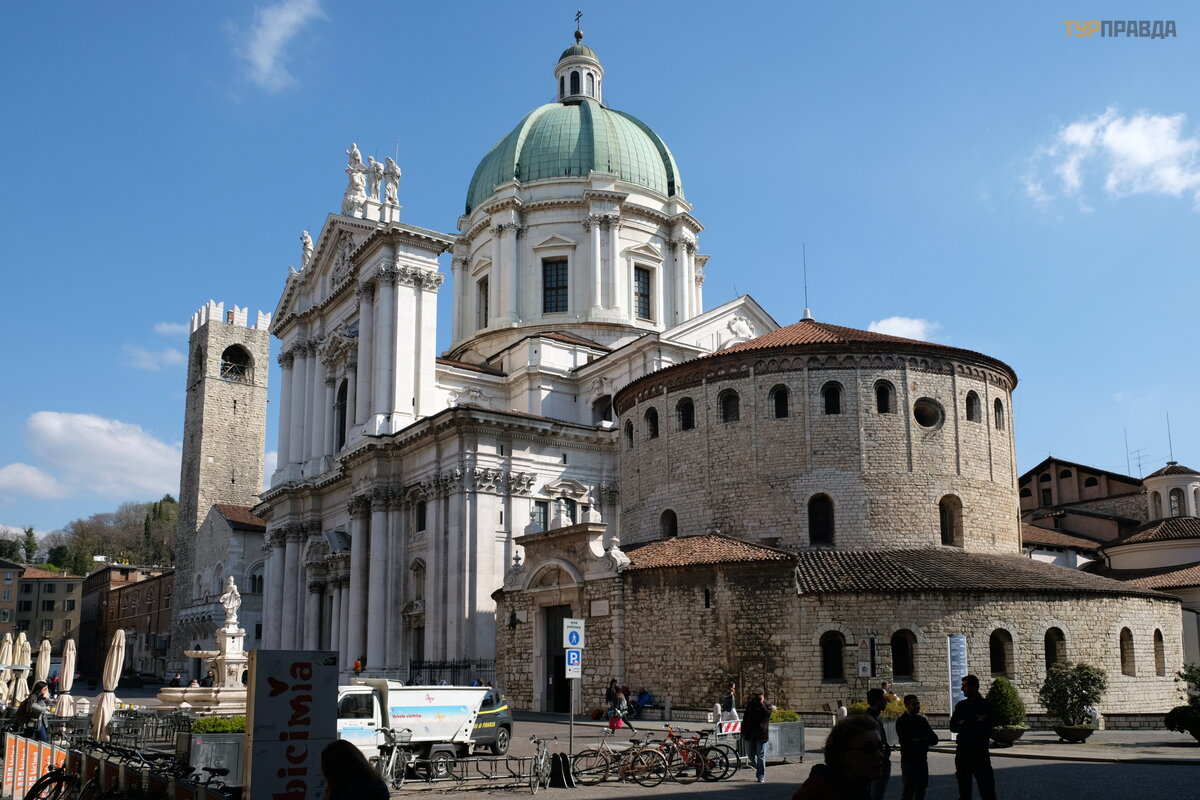
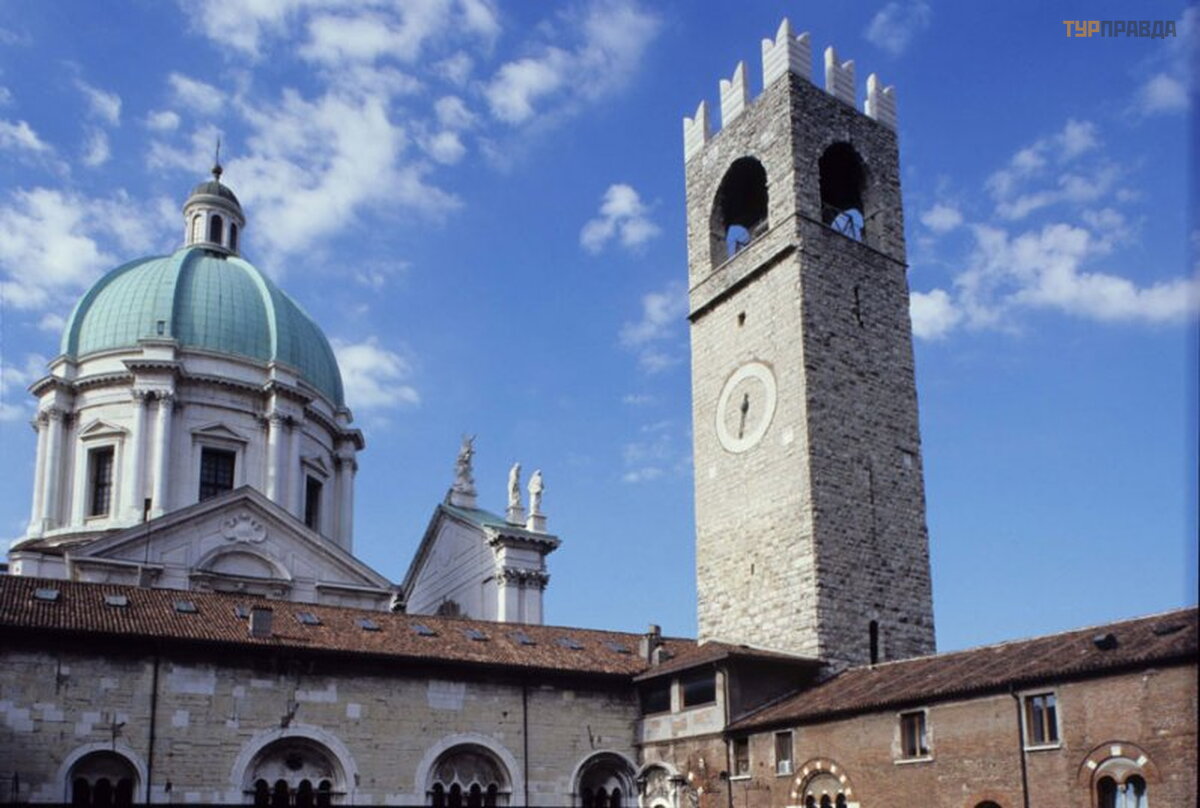
В центре площади есть два фонтана 18-го века.
На северной стороне, у Палаццо Бролетто, находится фонтан с копией неоклассической статуей Минервы. Это работа Джамбаттиста Giambattista Cignaroli 1818. Здесь она была установлена в 1921 году.
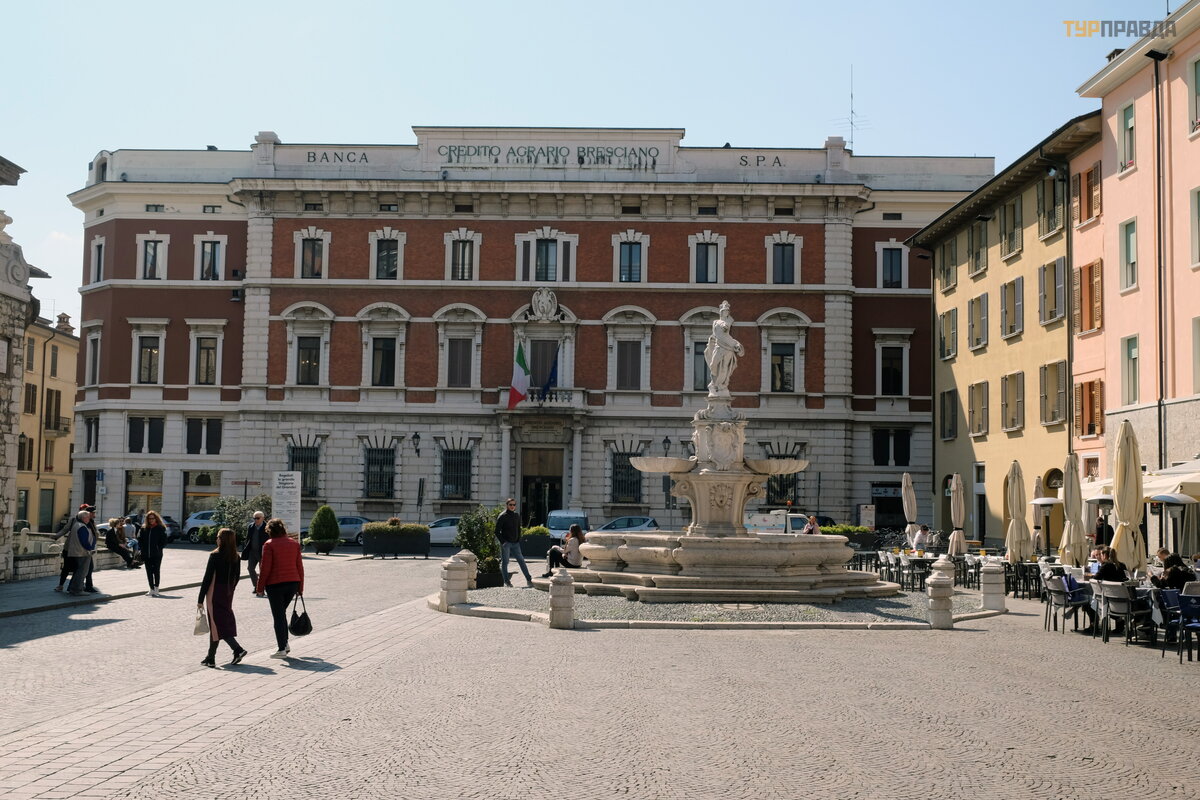
Старый Собор, представляющий собой прекрасный образец романской архитектуры. За округлую форму Собор называют также Ротондой. Есть у него и ещё одно название, официальное – Санта Мария Асунта (Concattedrale invernale di Santa Maria Assunta). Он был построен в конце 11 века на месте ещё более старой церкви 7 века Санта Мария Маджоре, которая, в свою очередь, была возведена на месте древней базилики 4-5 века. Вот такие исторические слои.
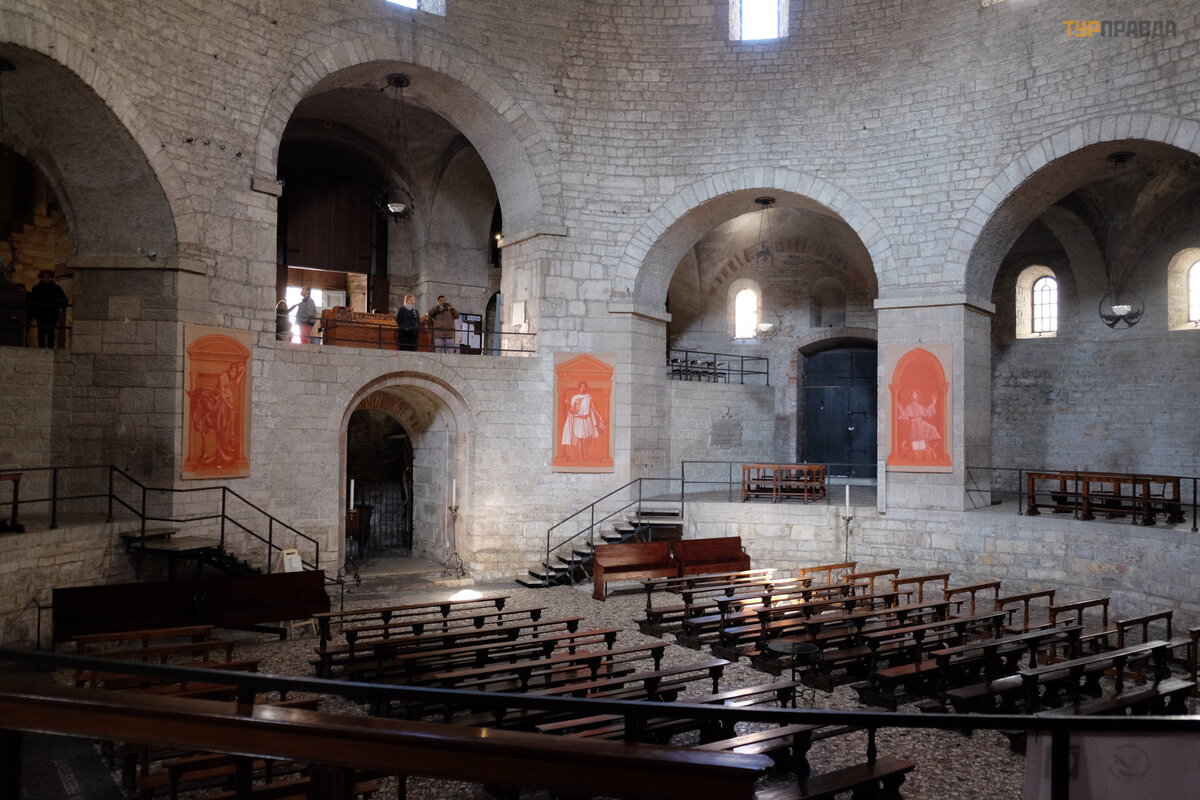
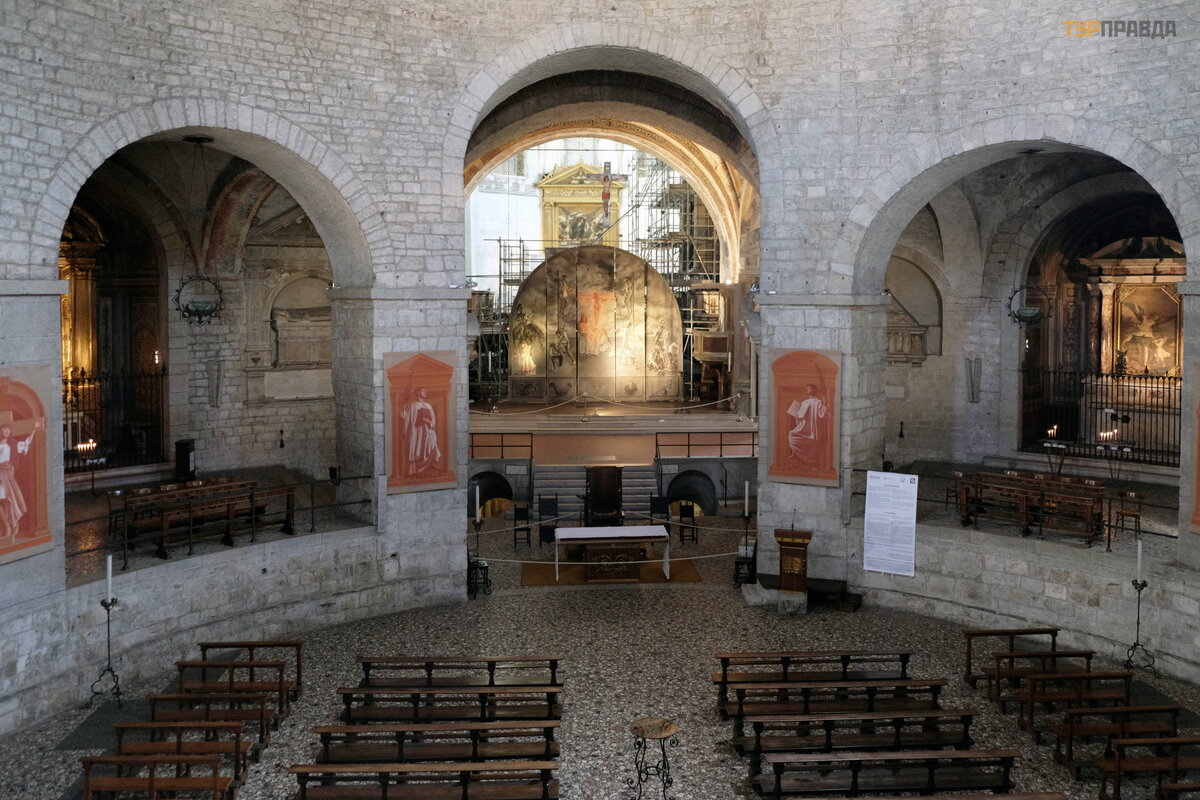
В соборе находится мраморный саркофаг Бернардо Маджи, епископа Брешии, положившему конец войны между гибеллинами и гвельфами. « Упакованный» в великолепный саркофаг из красного веронского мрамора.
В интерьере частично сохранились интересные фрески. Также здесь находится крипта одного из самых ранних христианских пастырей 4 века.
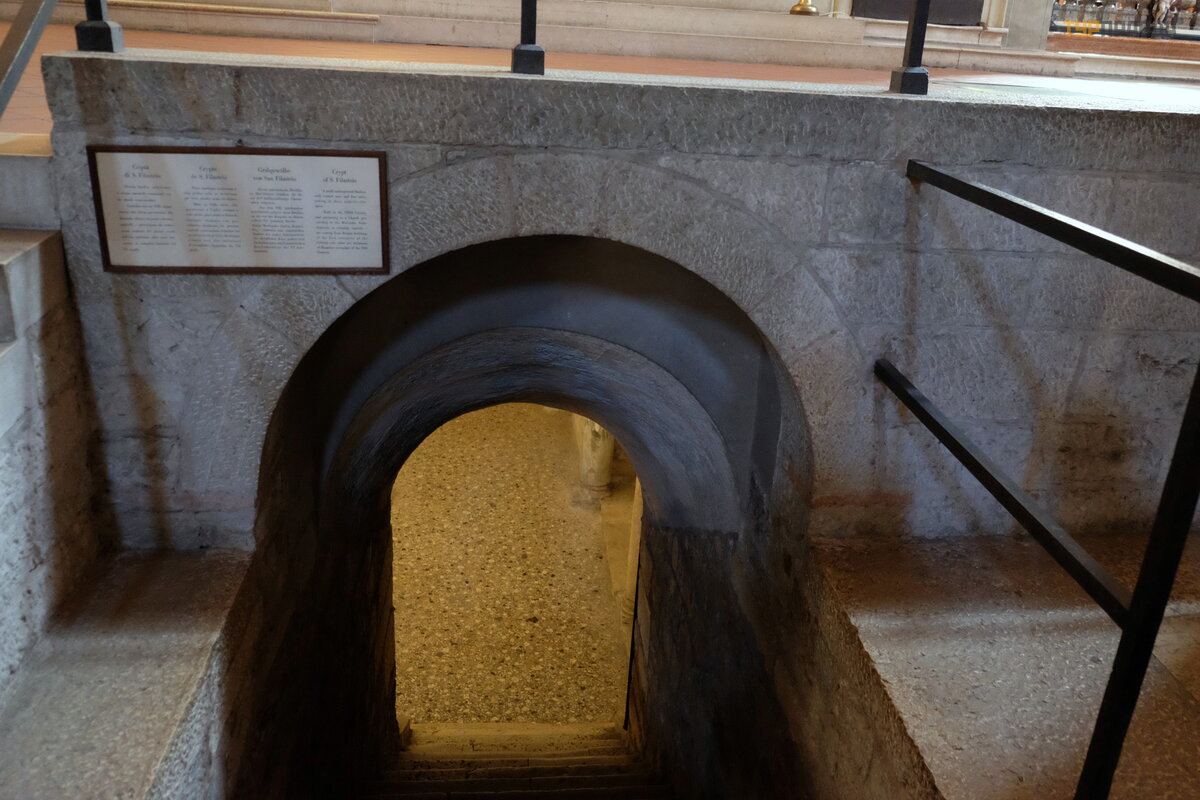
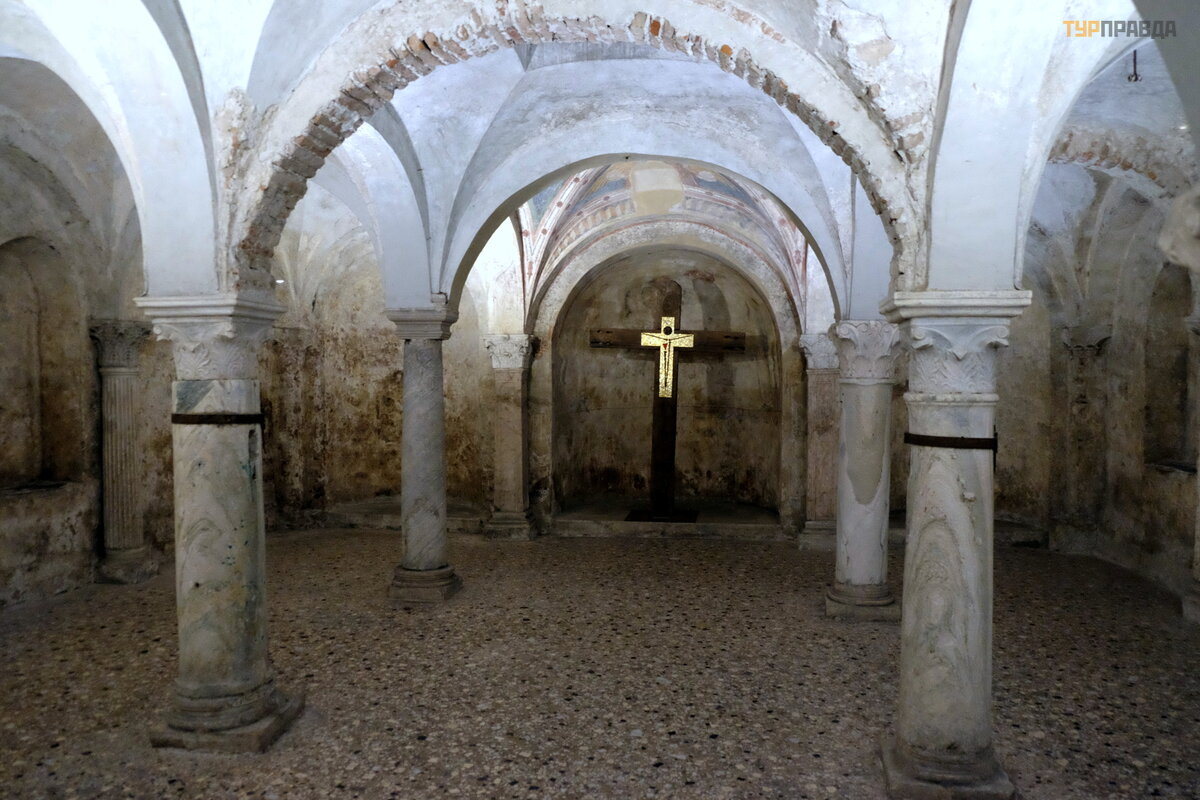
Стены и купол расписывал художник Моретто да Брешиа. Его фрески " Евангелисты Лука и Марк" , " Илия и Ангел" стали признанными произведениями средневекового искусства.
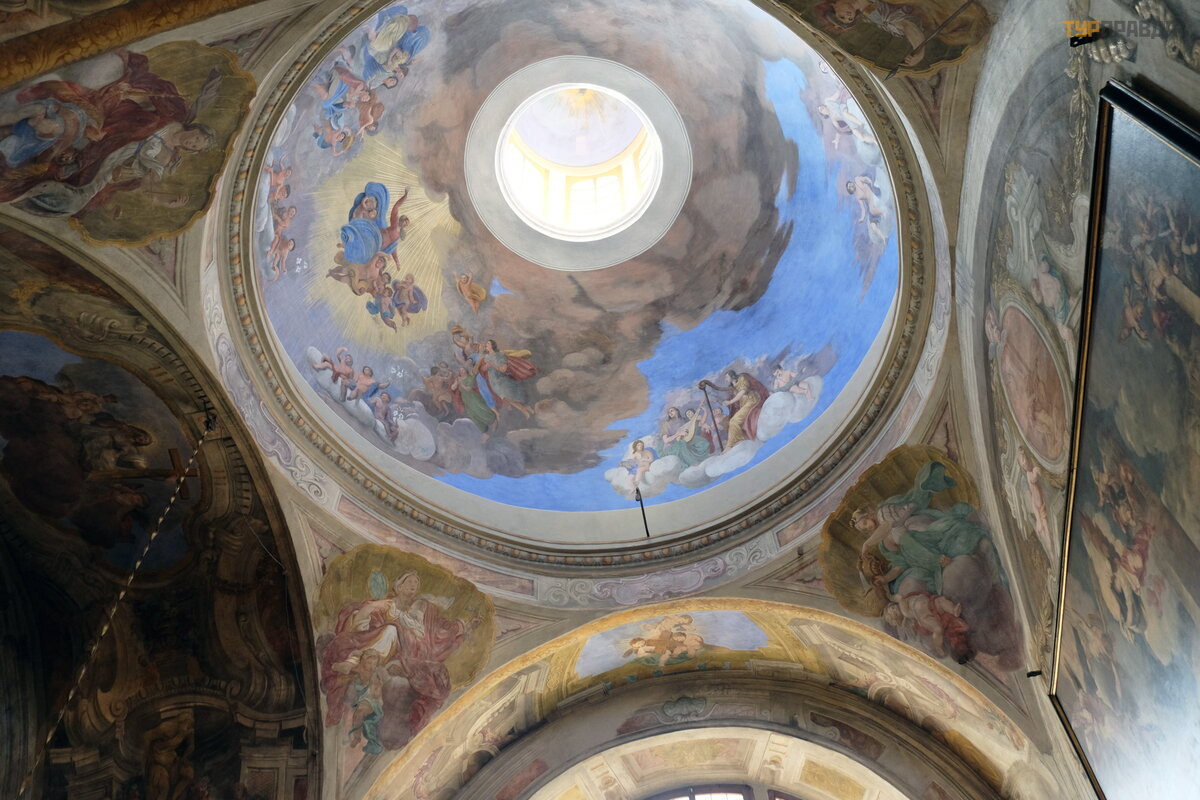
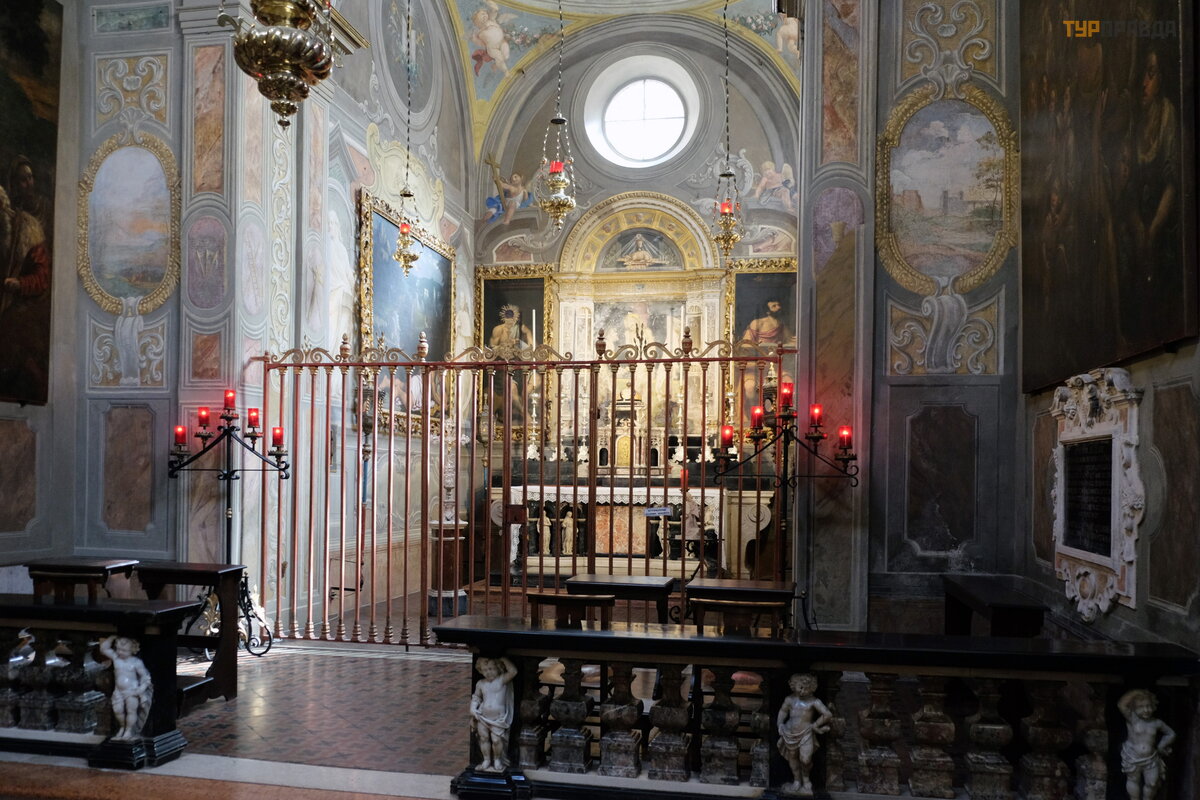
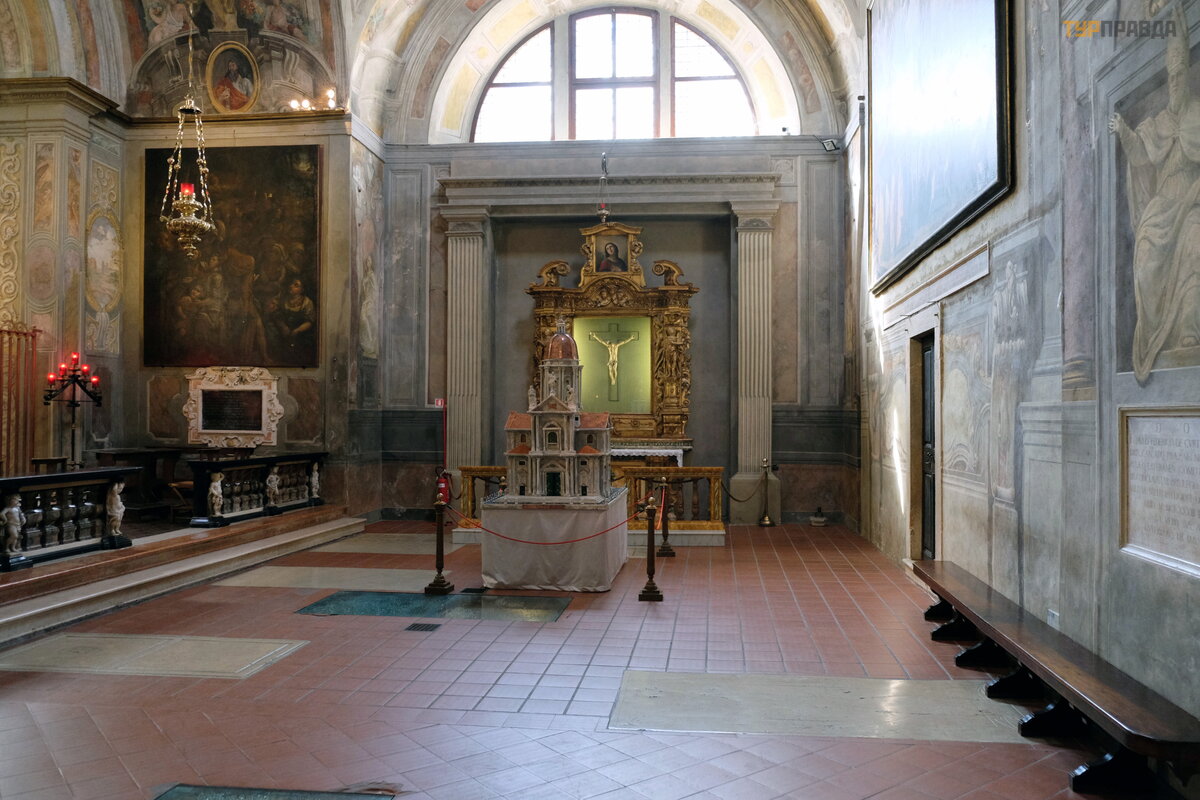
Новый кафедральный собор (летний собор Санта-Мария-Ассунта) начали строить ещё в XVII веке, а закончили в начале XIX-го. В процессе строительства был использован проект Андреа Палладио, родоначальника классического стиля. В итоге здание получилось смешанных стилей – неоклассицизма и барокко.
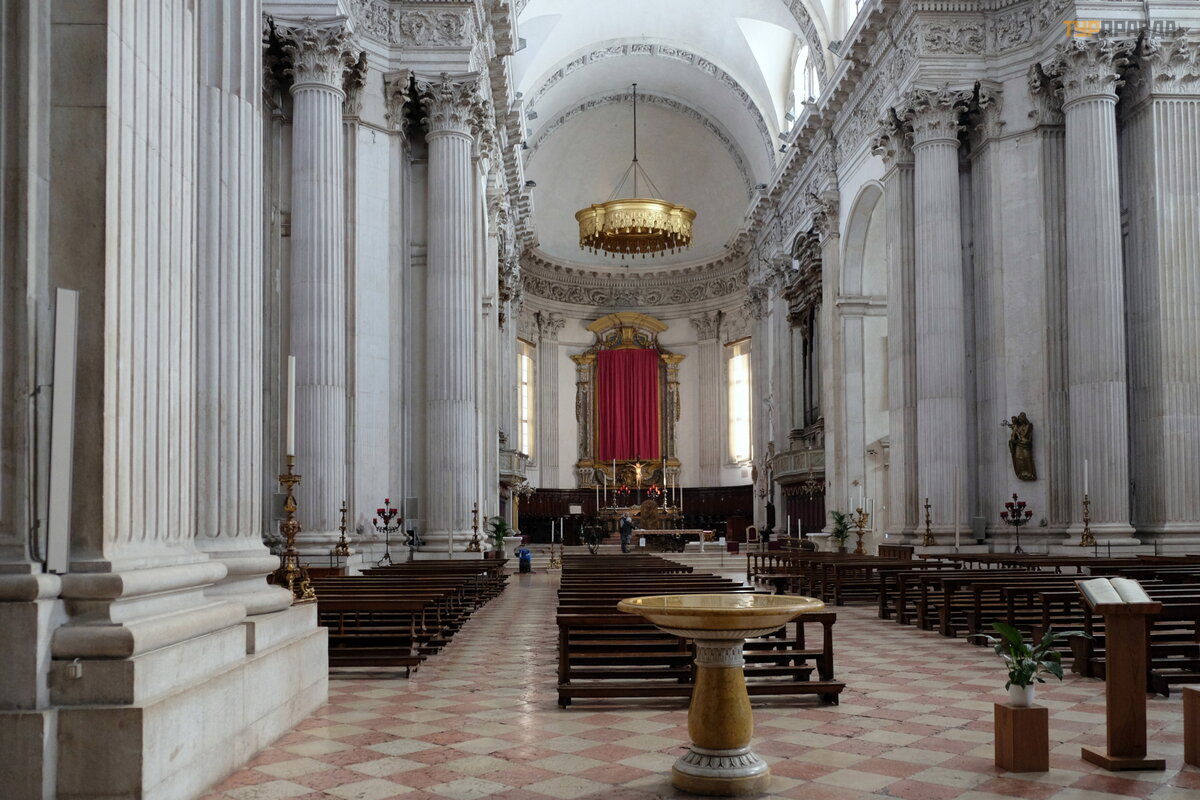
Венчает собор впечатляющий бирюзовый купол, который виден со многих точек города. Собор в Брешии по высоте (91 м) является третьим в Италии – после соборов Святого Петра в Риме и Санта Мария-дель-Фьоре во Флоренции.
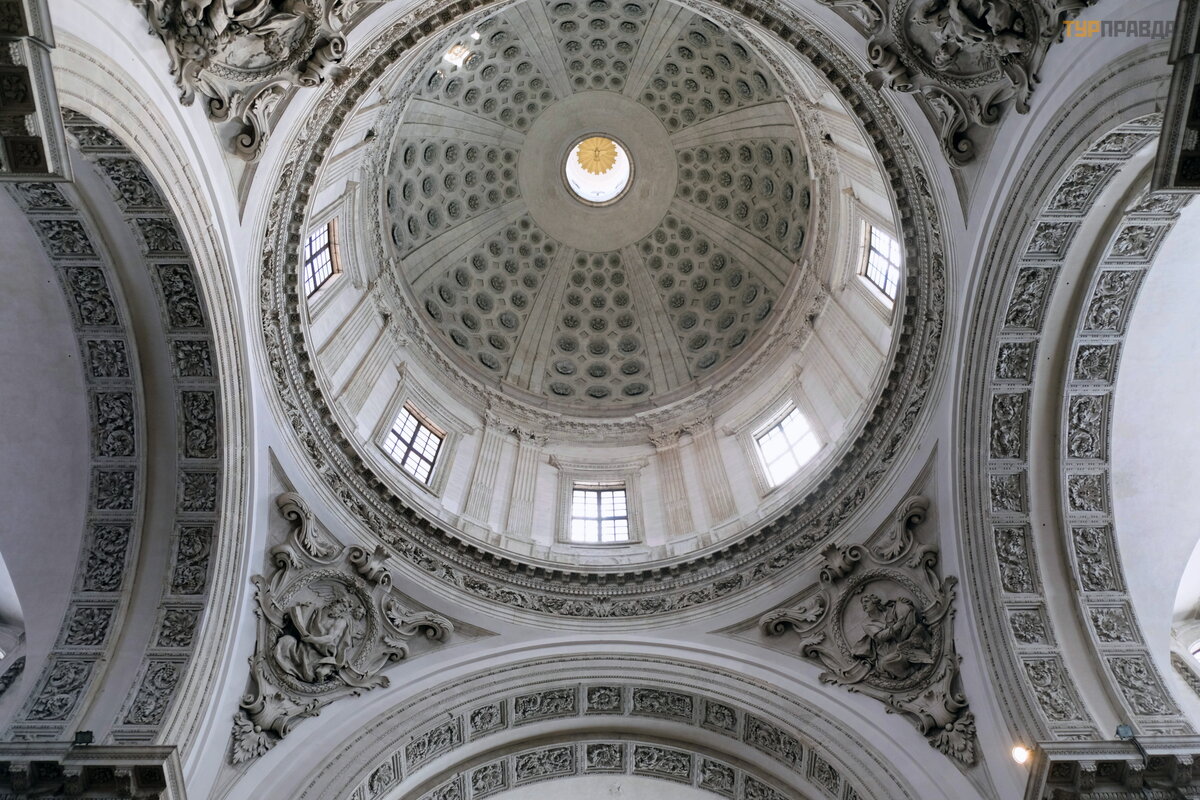
Внутри могила папы Паоло VI. Работа современного скульптора Раффаэле Скорцелли 1984 года.
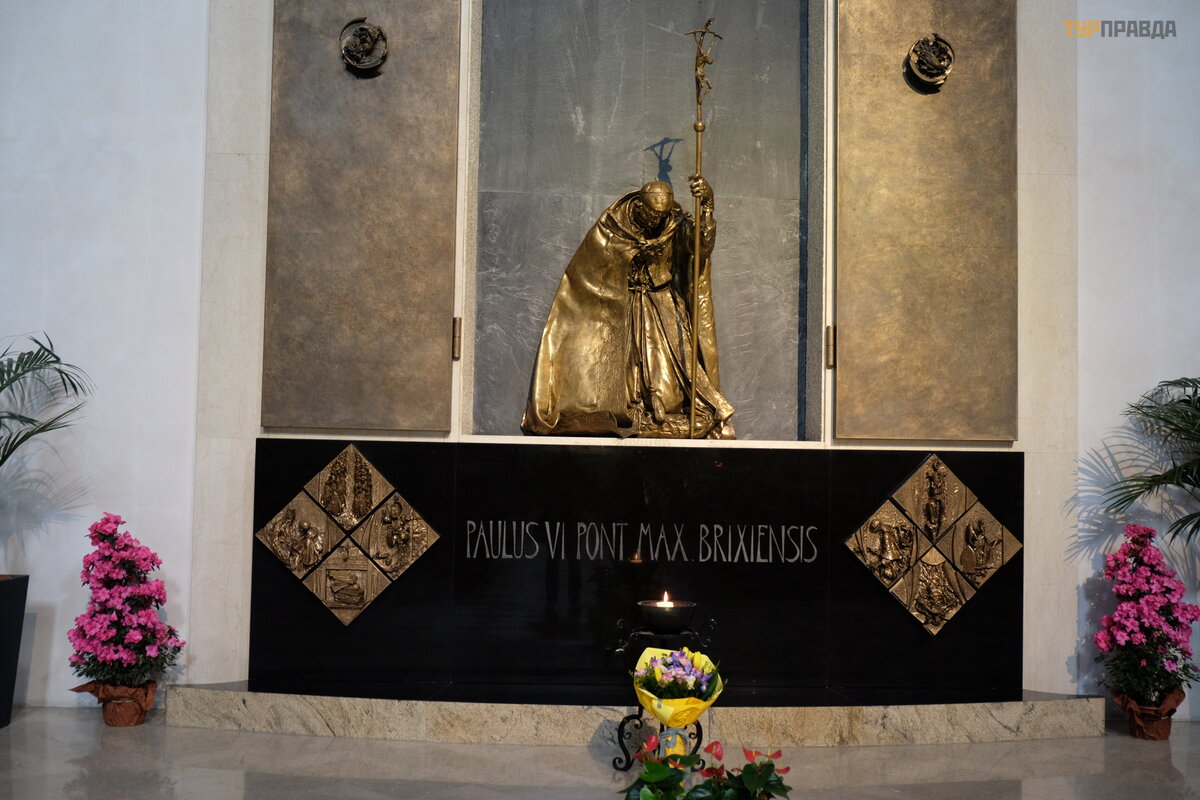
Внутри собор расписывали художники Брешии – Моретто и Якопо Пальма младший.
Алтарь работы Родольфо Вантини с живописью Моретто да Брешиа " Жертвоприношение Исаака" .
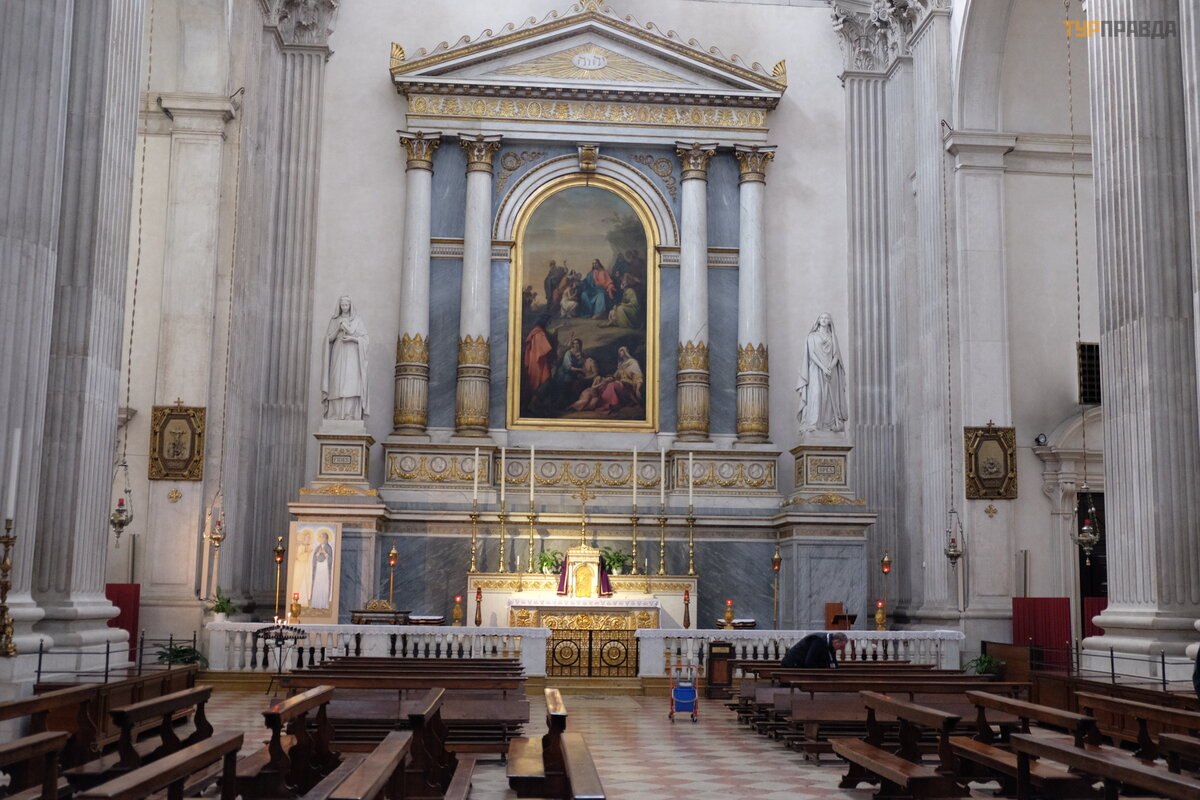
Алтарь справа. Он включает монументальный ковчег Святого Аполлония, украшенный изысканными барельефами и замечательными скульптурами эпохи Возрождения Гаспаро Кайрано (1508-1510).
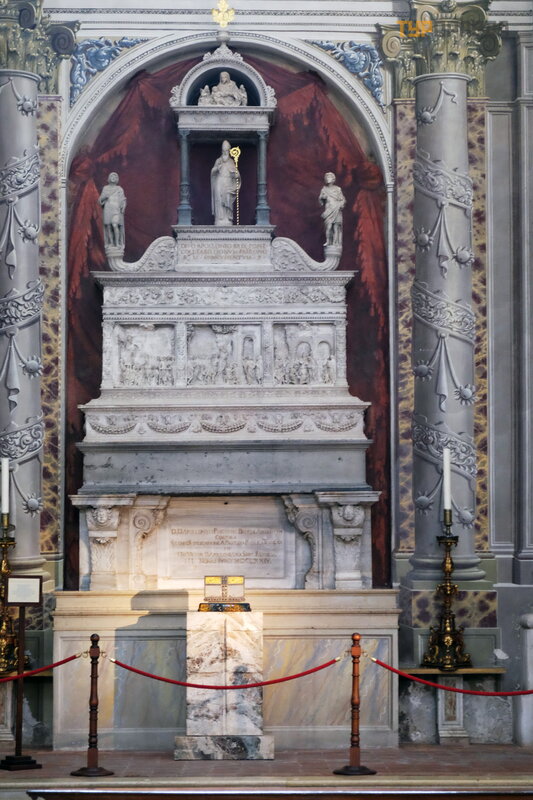
Осмотрев соборы, мы перешли на другую очень интересную площадь – Пьяцца Витториа (Площадь Победы).
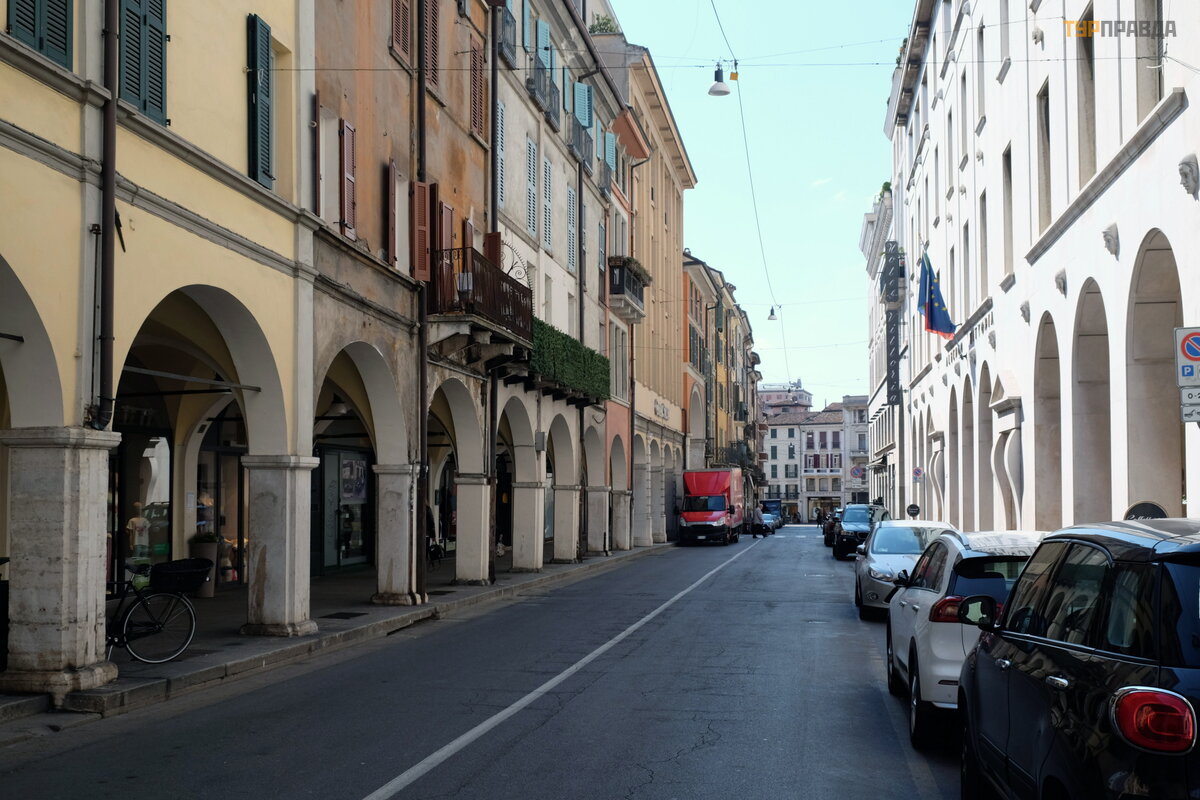
Площадь выстроена в неоклассическом стиле главным архитектором эпохи Муссолини – Марчелло Пьячентини. Архитектор создал очень гармоничный ансамбль к 1932 году, площадь была посвящена десятилетию установления фашистского диктата Муссолини. Площадь окружена публичными дворцами. Центральное здание – Дворец почты. Беломраморгая Башня Реводюции с часами – всякие советы и учреждения.
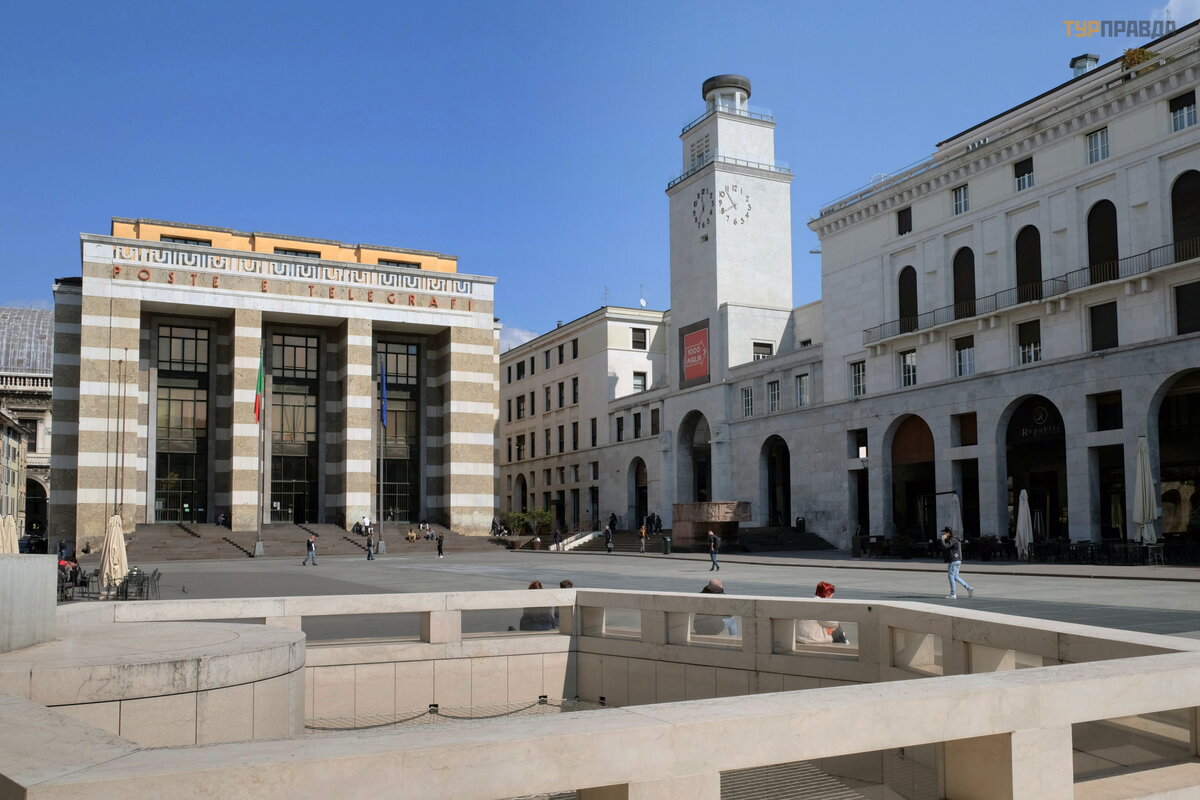
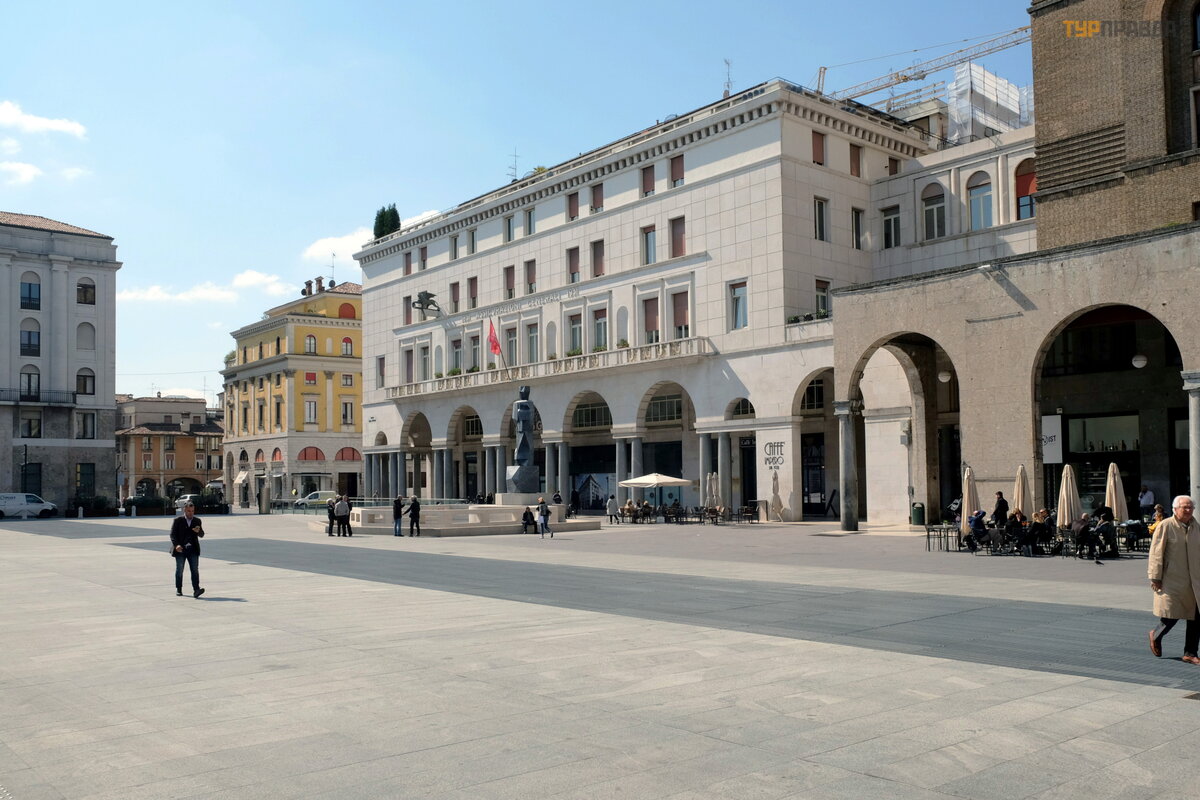
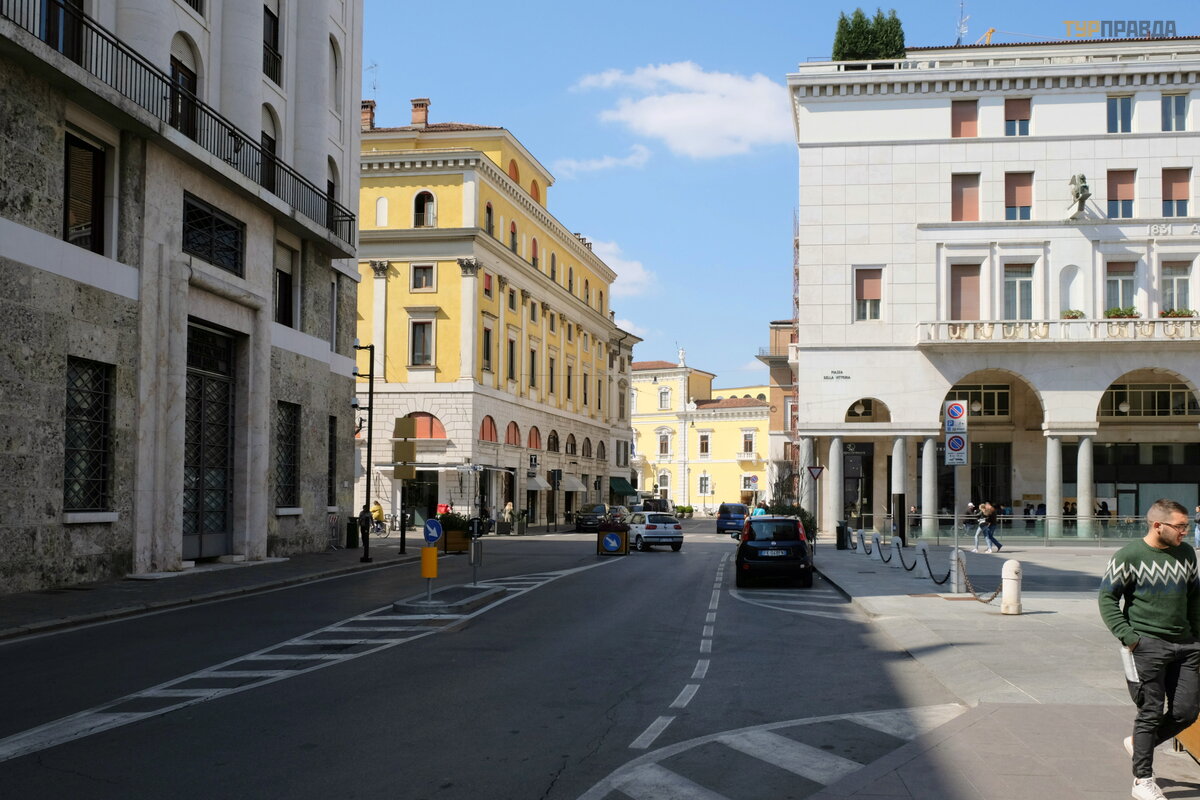
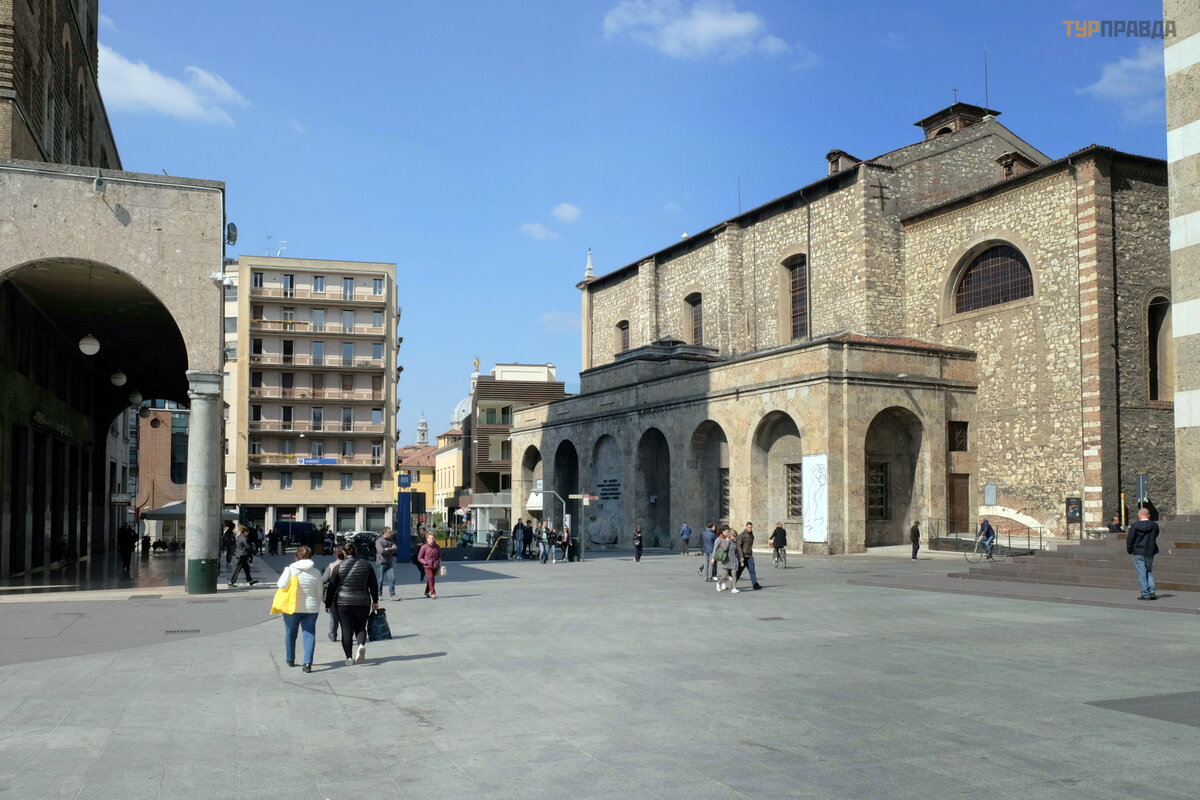
Первый бетонный небоскреб Италии в 13 этажей.
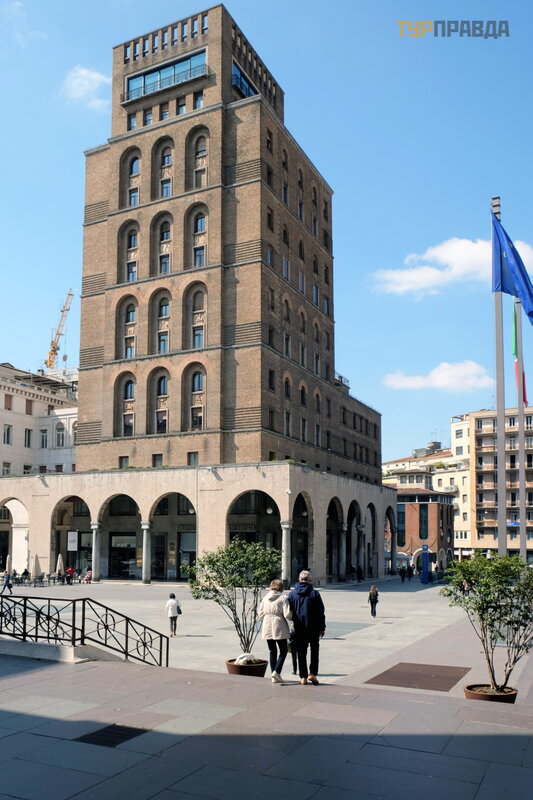
Дворцы были обильно украшены рельефами с изображением различных культурных событий и героев брешианской истории. Античная Витториа Алата, святые Фаустино и Джовита, покровители города, а также известные художники и герои Первой мировой, и, конечно же, герои фашизма вместе с самим Бенито Муссолини.
Но Муссолини и фашисты исчезли с рельефов после 1945 года. У подножия башни Революции установлена внушительная мраморная трибуна – место публичных выступлений Муссолини.
Через короткий переход перешли на ещё одну примечательную площадь, уже средневековую – площадь Лоджии (Piazza della Loggia). Площадь начали застраивать в середине XV века во времена вхождения Брешии в венецианское царство. По периметру выстроились ренессансные здания.
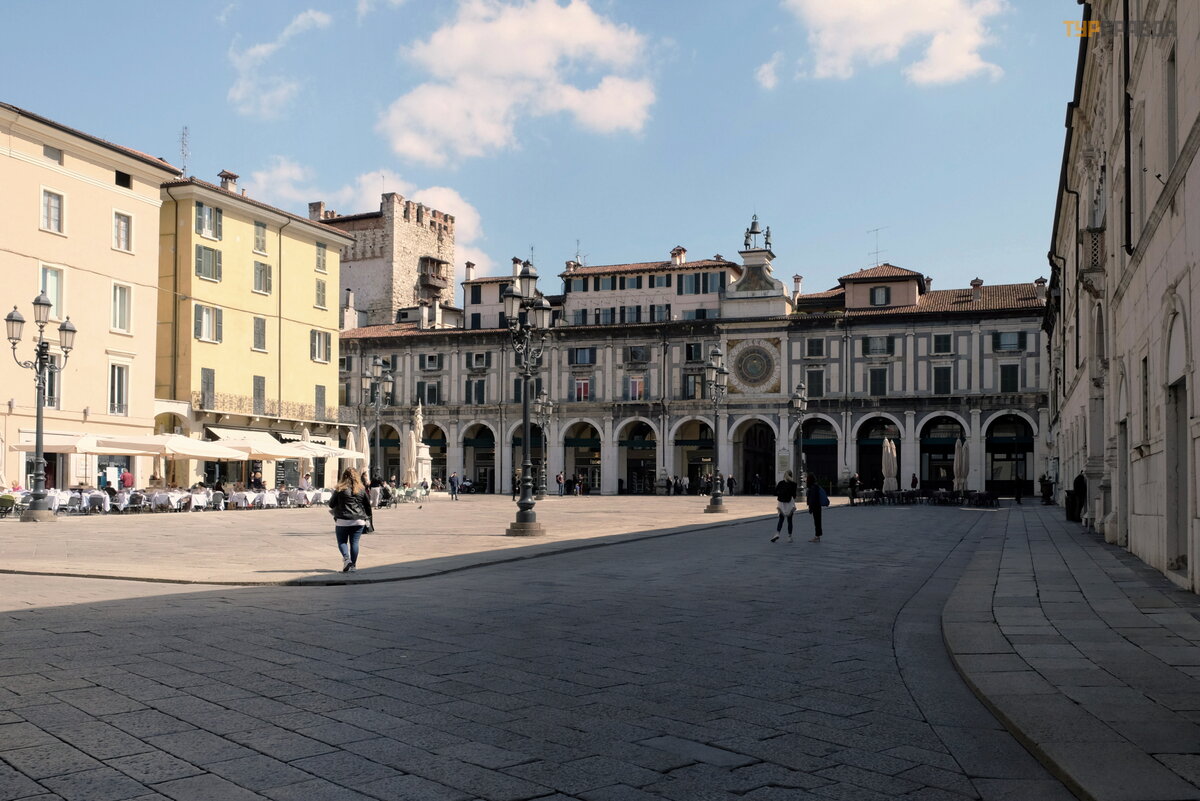
Главное здание на площади – Палаццо Лоджия, в нем сейчас находится мэрия Брешии.
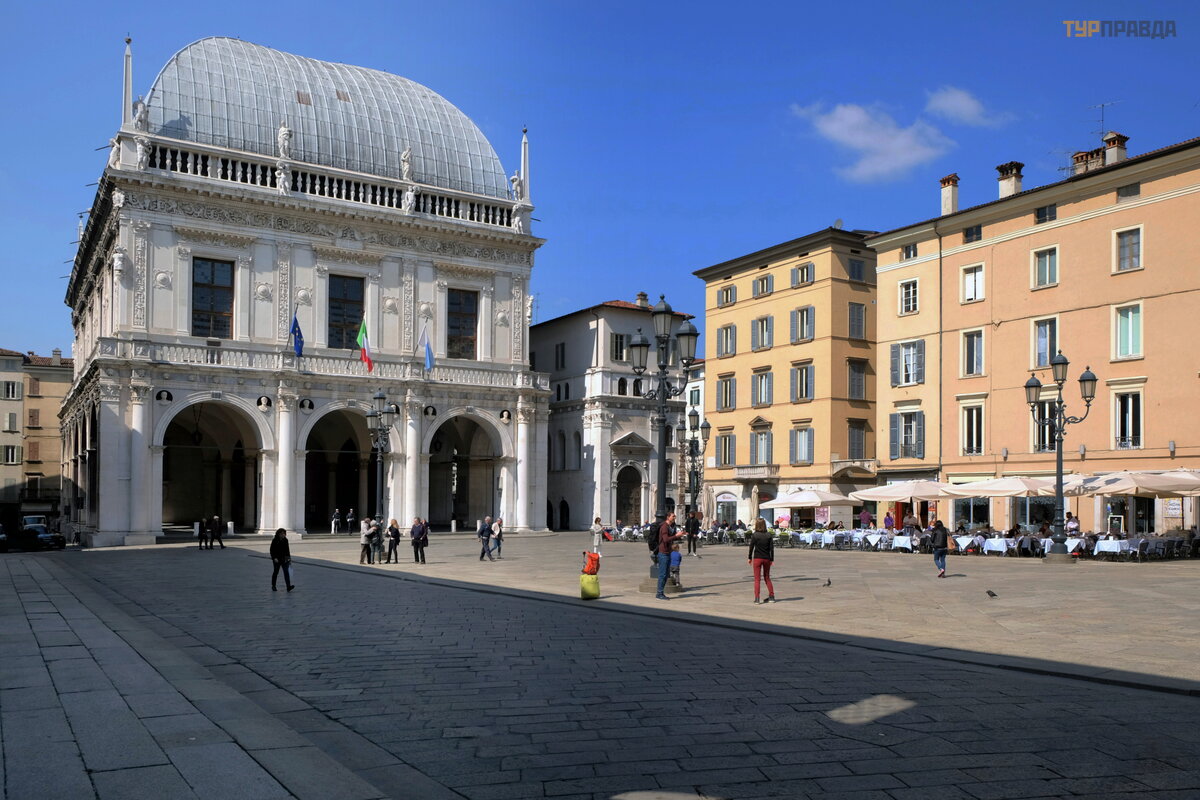
На противоположной стороне – здание с аркадой и с часовой башней Оролоджо.
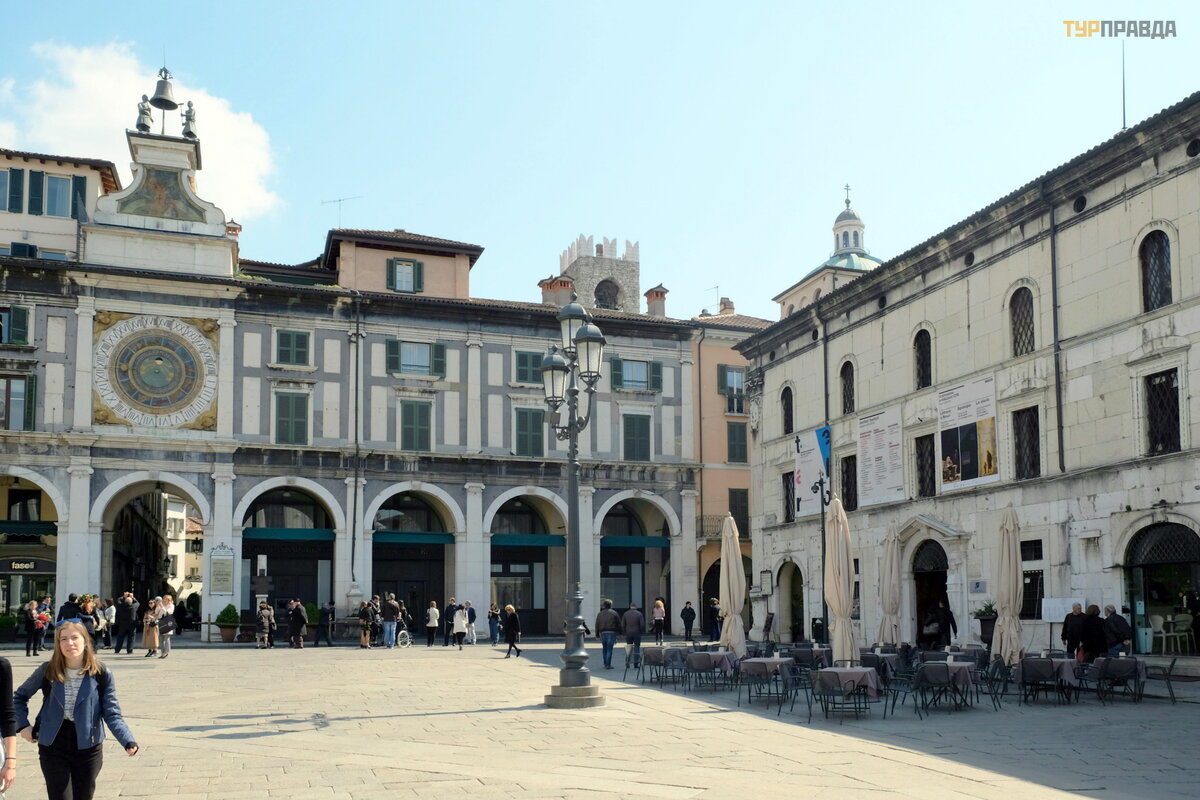
В 1864 г. была установлена скульптура Красавица Италия (Monumento alla Bella Italia), посвященная десятидневному восстанию против австрийцев в 1849 году.
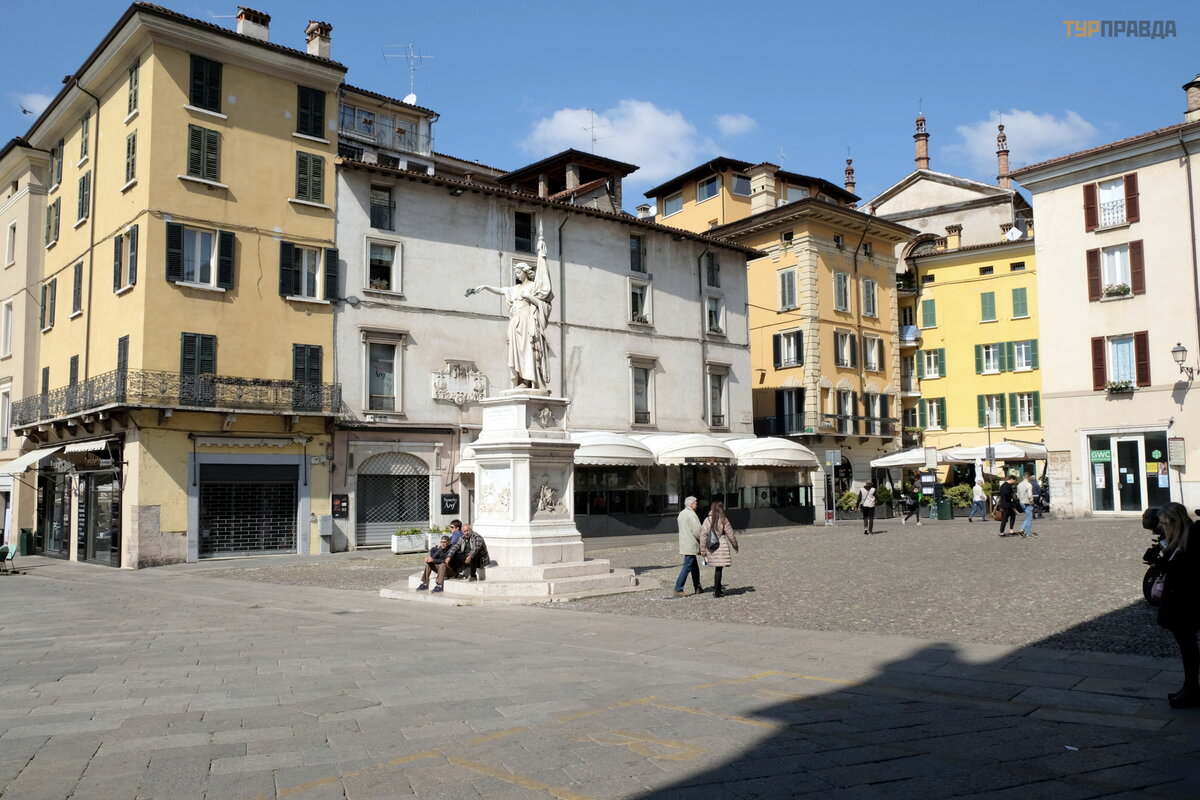
Обойдя Палаццо Лоджиа, идем в сторону Циднейского замка (правильно по-итальянски – Чиднео), возвышающегося над городом.
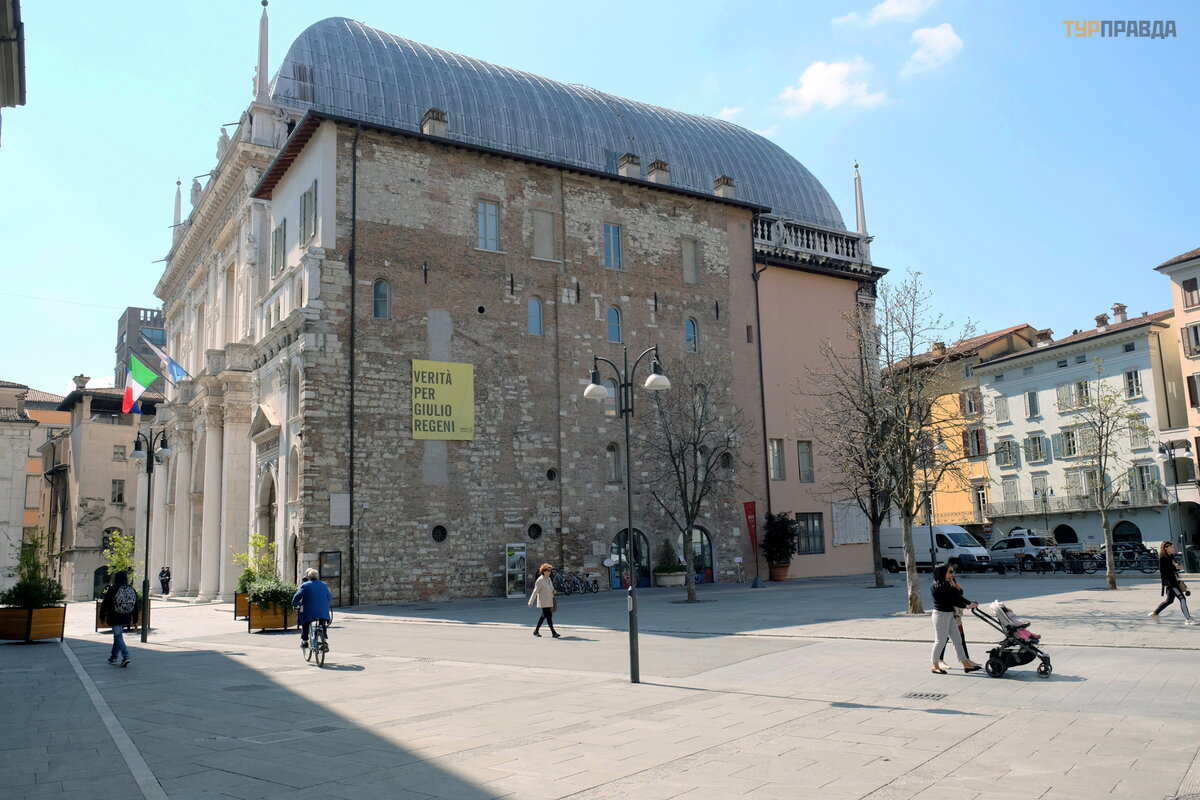
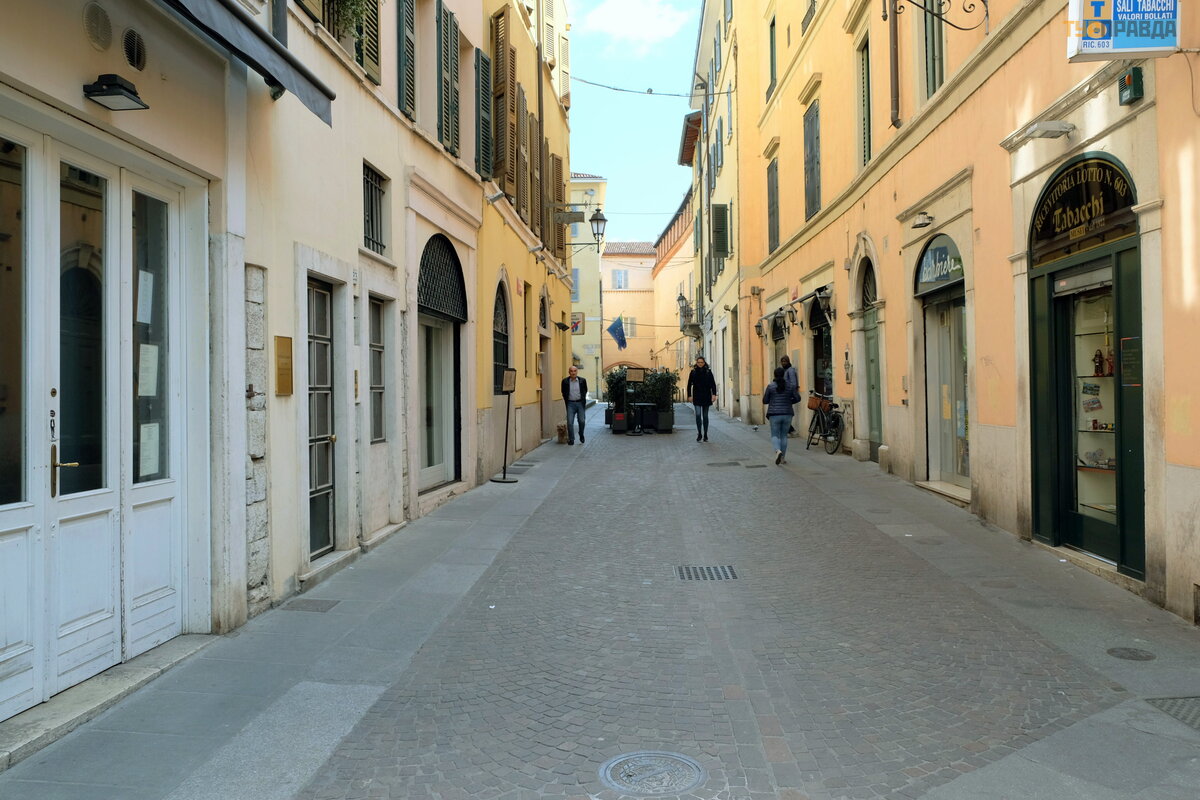
Непосредственно путь к крепости начинается от площади Тито Спери, названной по имени героя войн за независимость Италии от Австрии 1848-1849 гг. На площади установлен памятник Тито Спери.
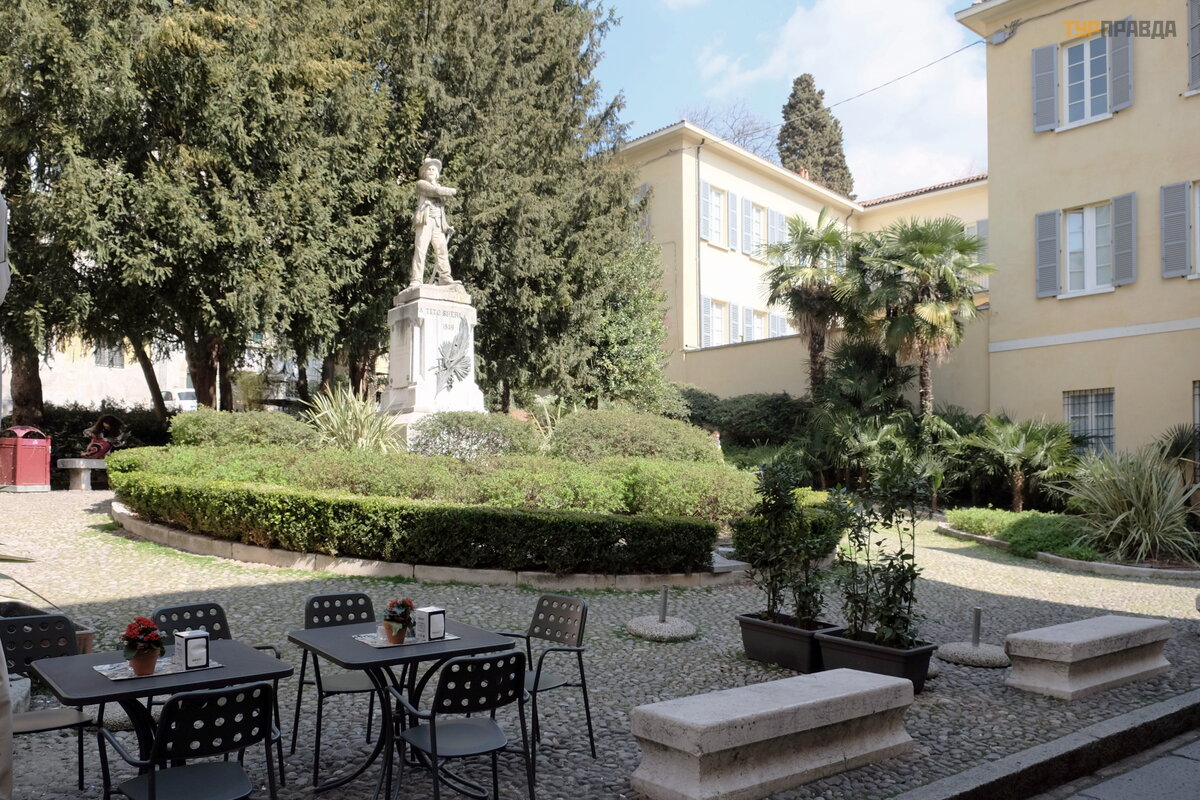
Рядом церковь Санта-Мария-делла-Карита (Святой Марии Милосердной).
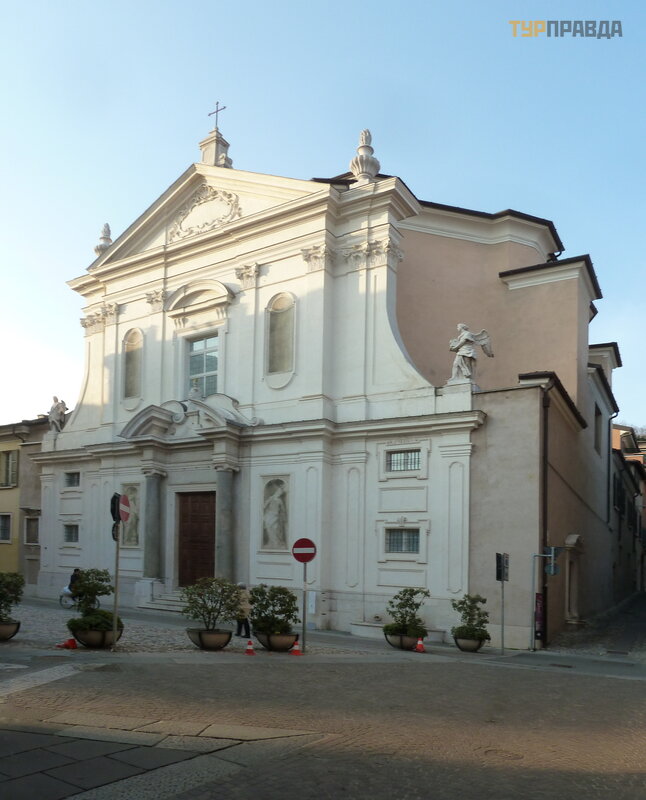
Церковь построена в 1640 году по проекту Агостино Аванцо на месте монастыря начала XVI века, в котором находили приют раскаявшиеся падшие женщины. Богатая отделка интерьеров была закончена в 1755 году. Невероятно красивы алтарь и пол из цветного мрамора.
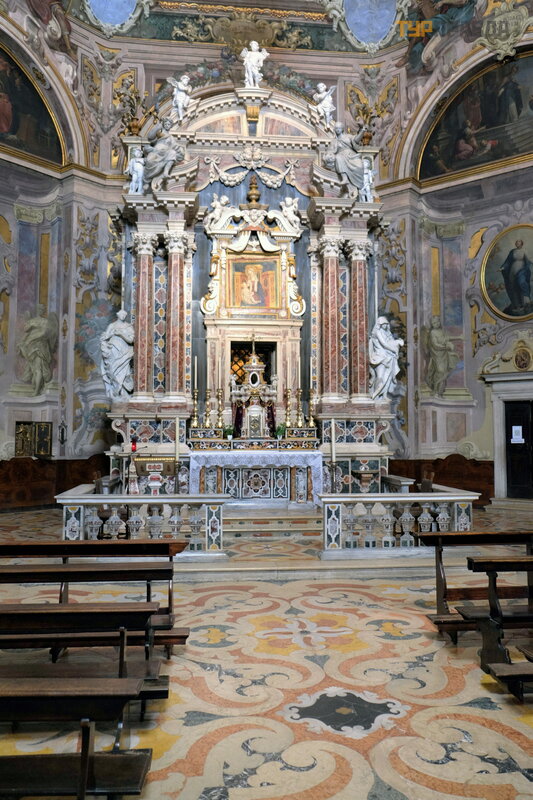
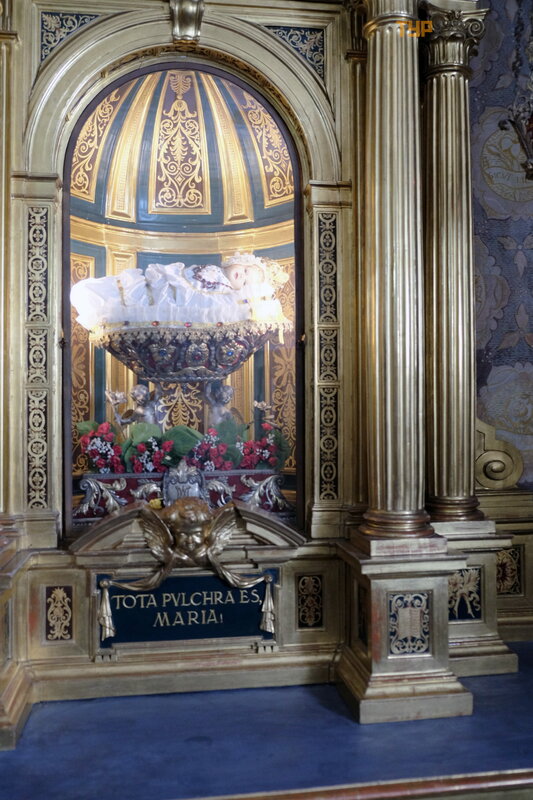
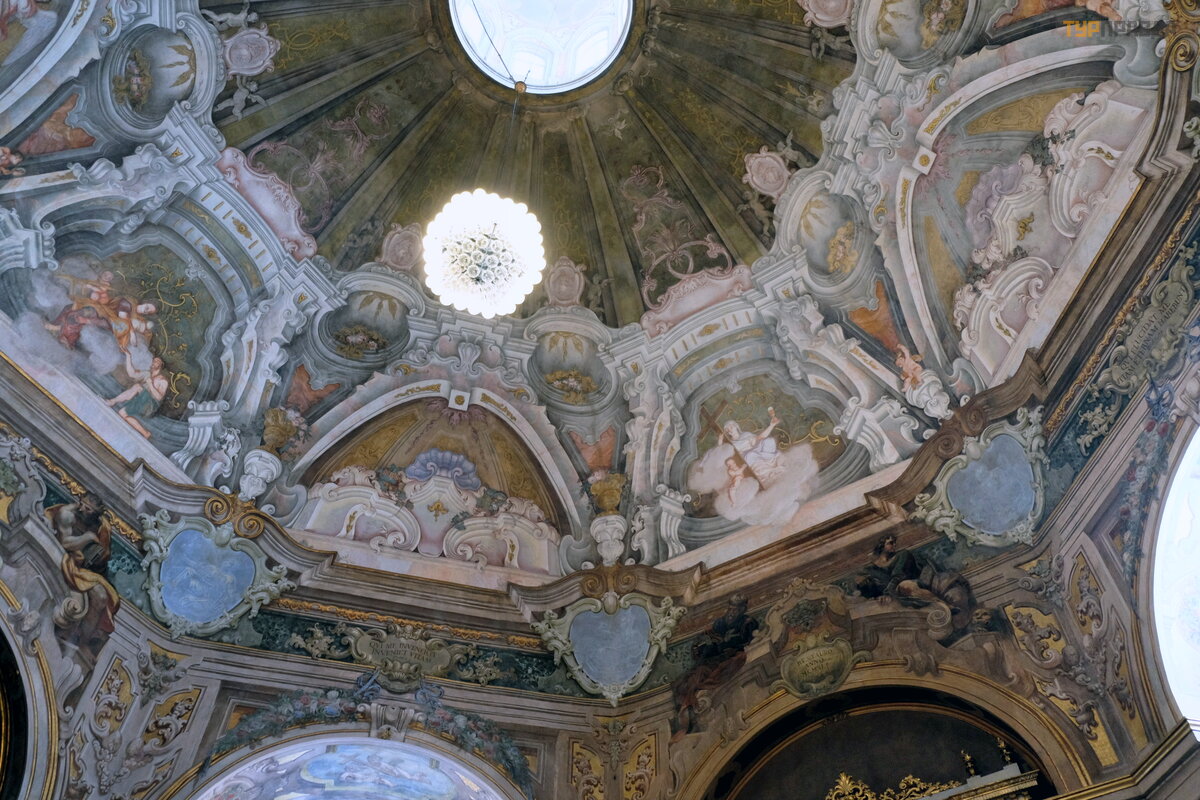
Дальше мы сбились с пути, почему-то подумали, что вход в замок находится на другой стороне тоннеля.
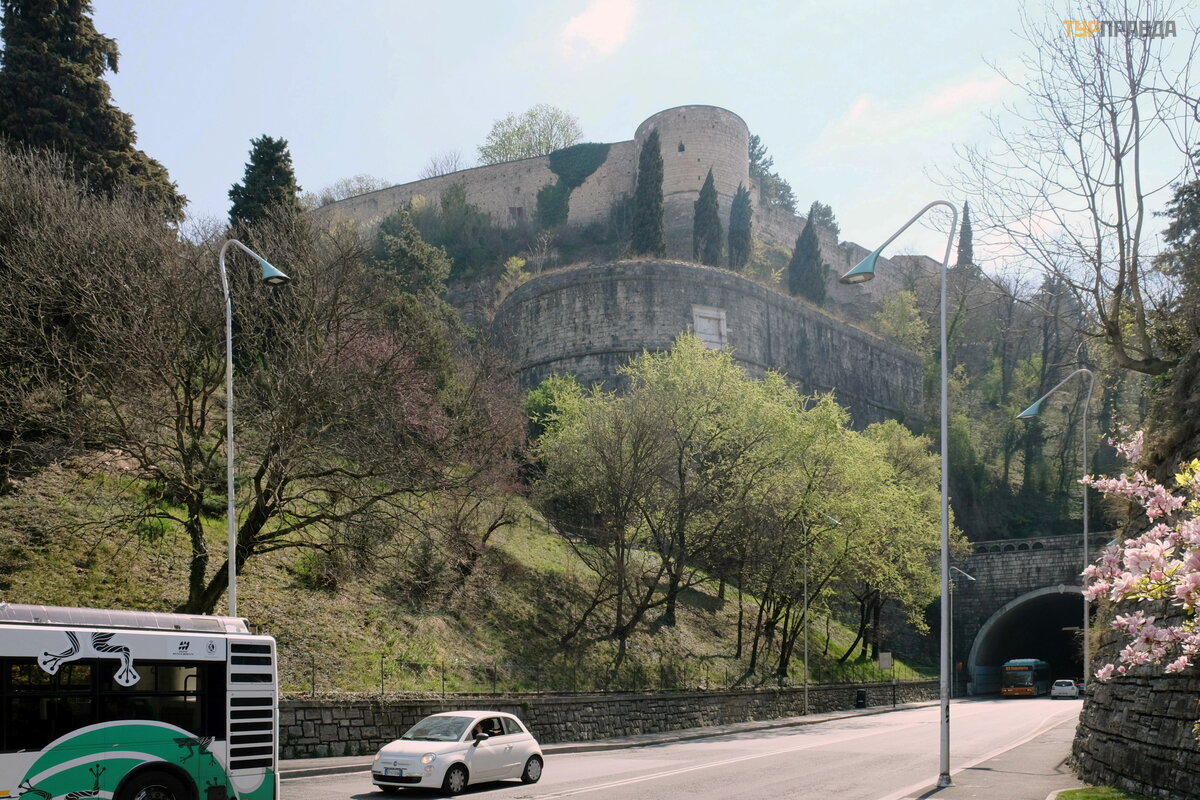
Но пришлось повернуть назад.
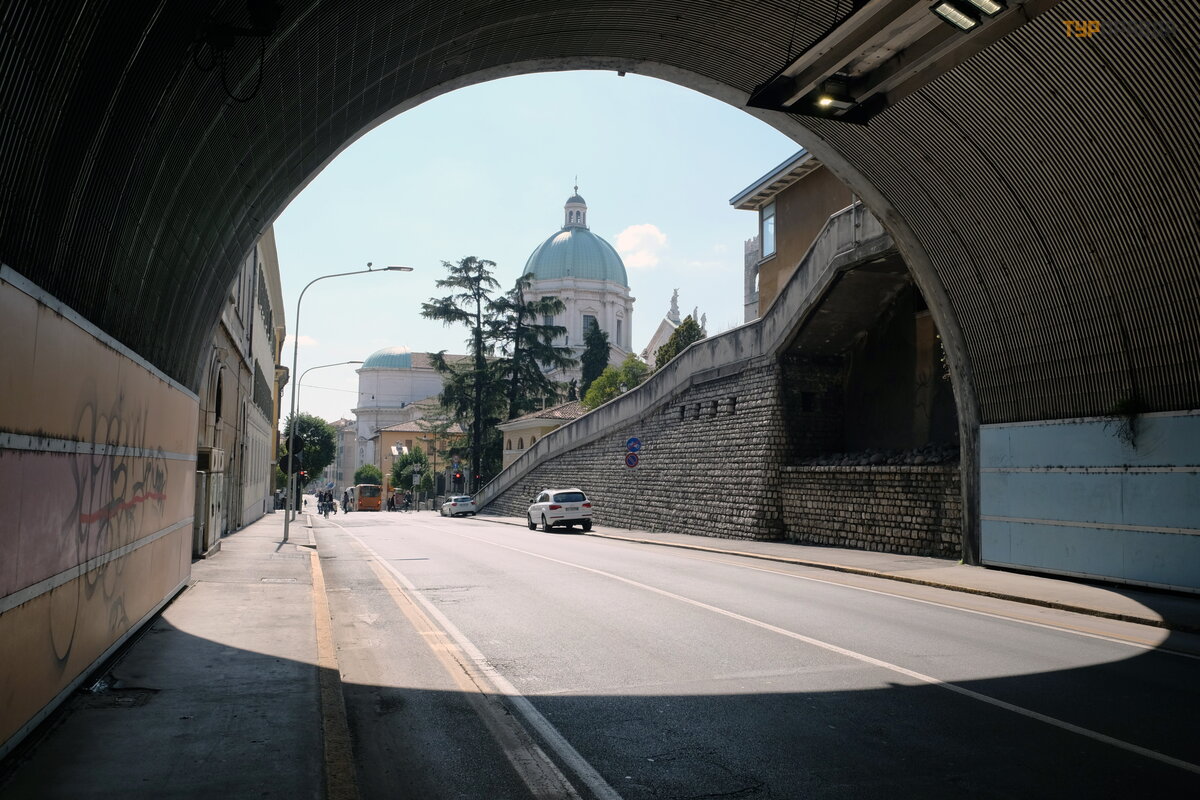
Дальше уже только поднимались только вверх.
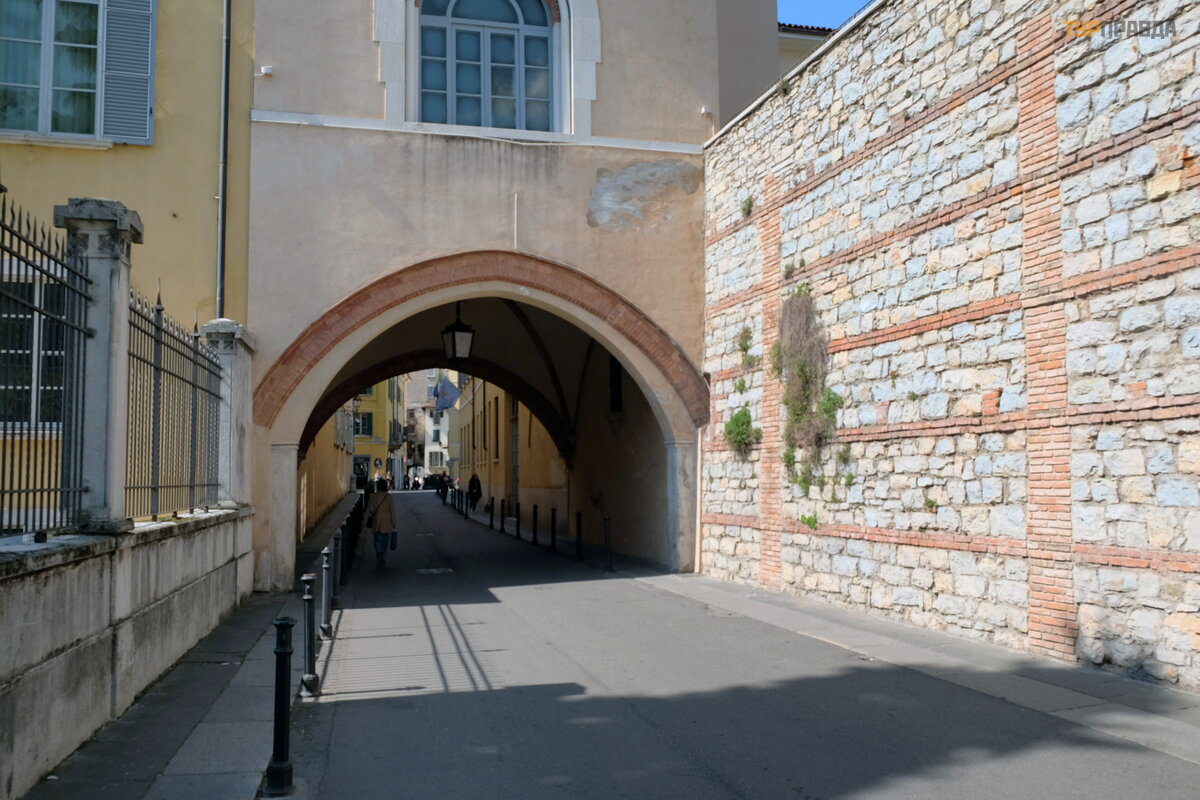
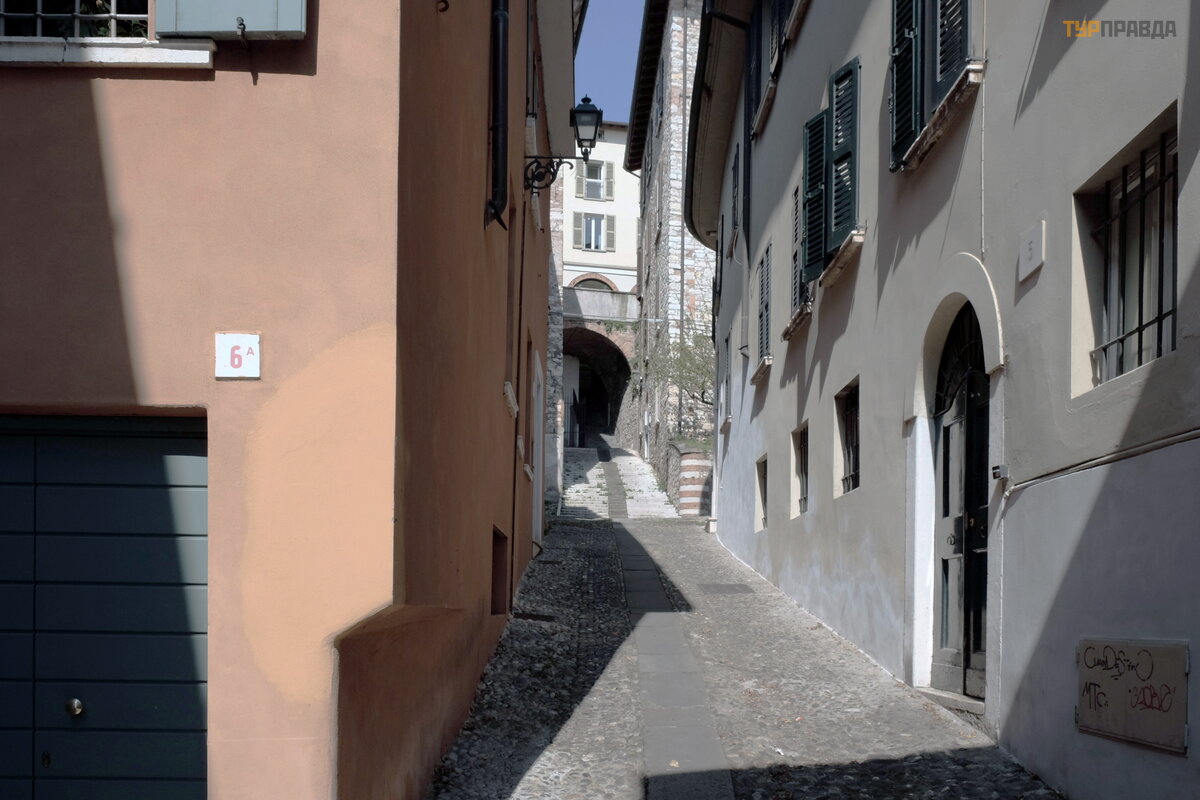
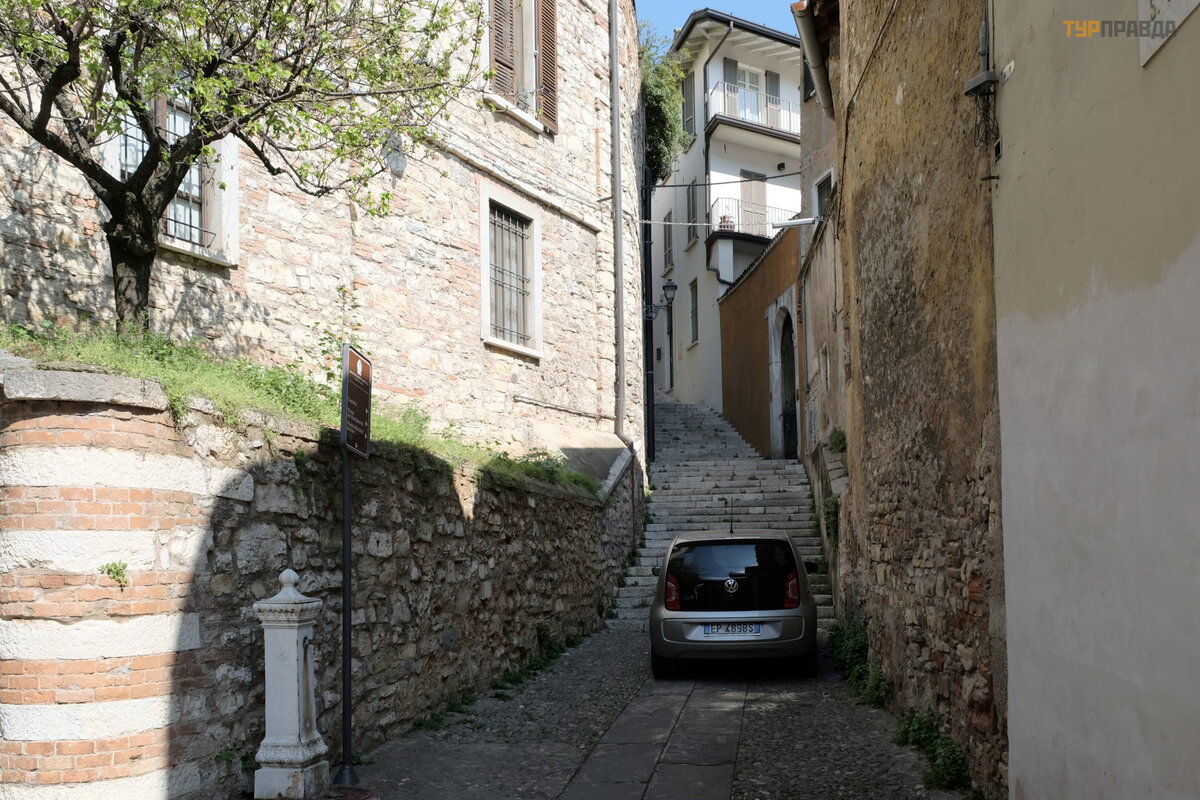
Наконец, дорога приводит к мосту через ров, который ведёт к воротам (16-го века) в крепость. Ворота украшены крылатым львом – символом Венецианской республики.
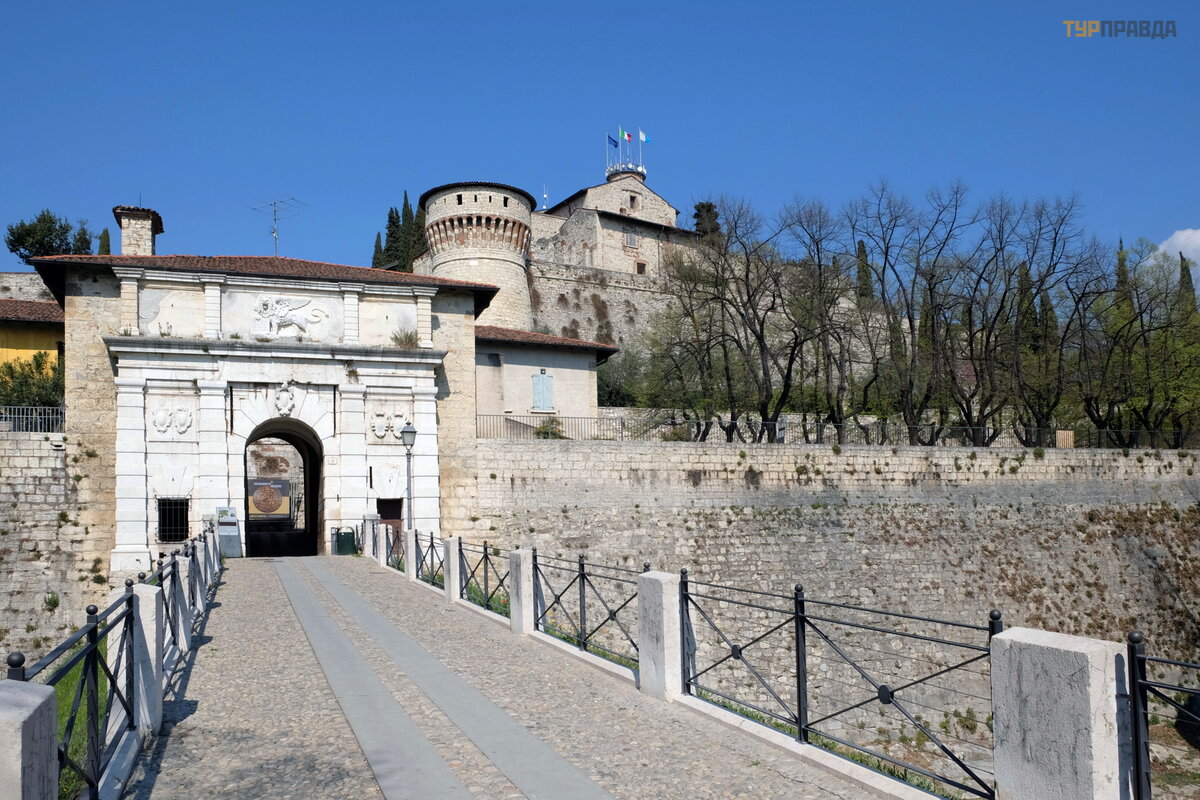
Самая древняя часть замка – цилиндрическая башня Mirabella, построенная на фундаменте позднего римского периода в 12-13 веках. В 14 веке имеющиеся сооружения были расширены, построены донжон и две башни, усилены зубчатые стены.
Интересно, что в апреле 1799 года, когда Брешия была занята Наполеоновскими войсками, замок осаждала русско-австрийская армия под командованием Суворова. После нескольких часов обстрела французский гарнизон сдался.
Проходим через ров и попадаем на территорию крепости-замка, которая оказывается огромной, с многочисленными бастионами, башнями, переходами, туннелями. Вход в замок свободный.
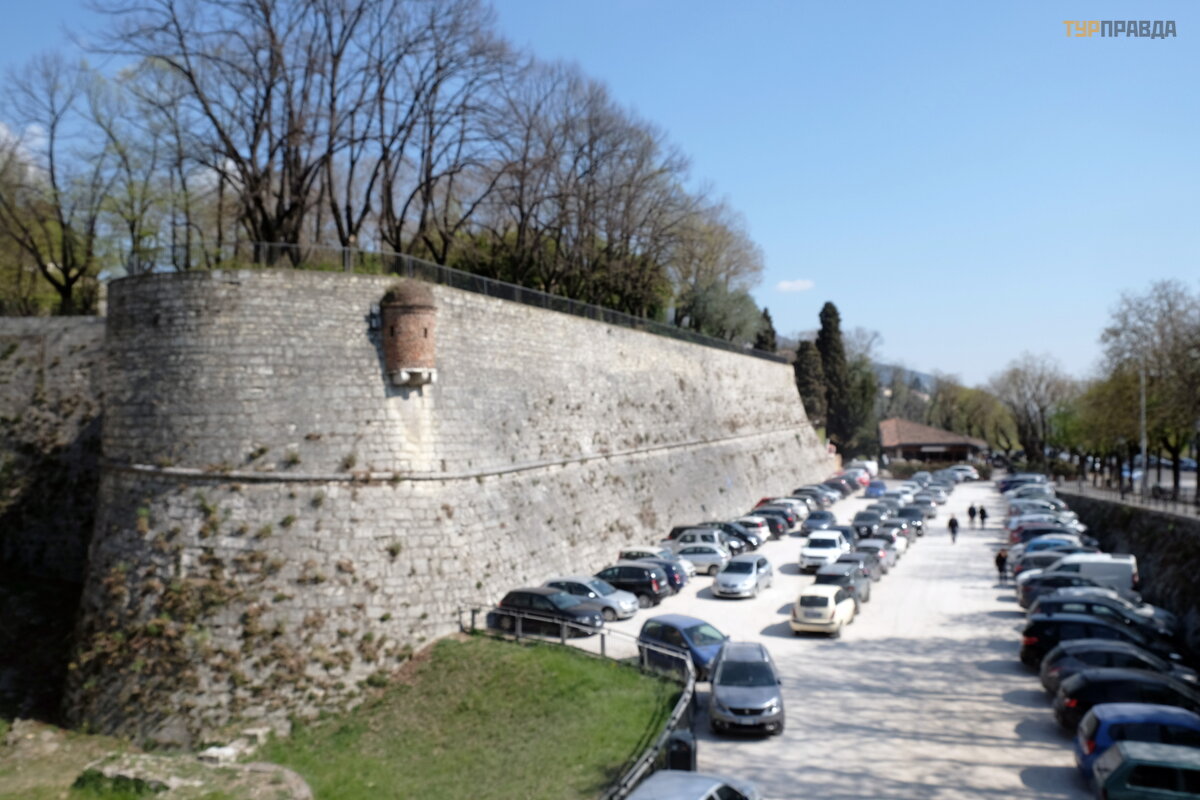
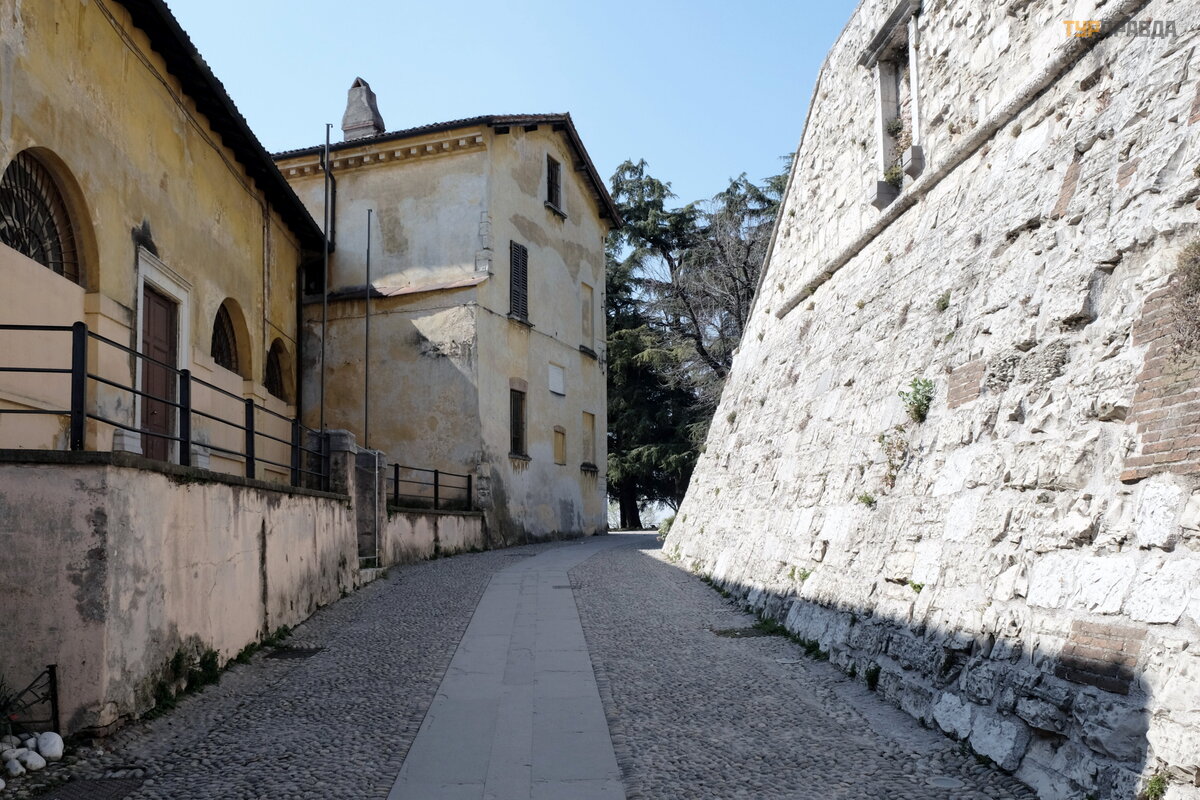
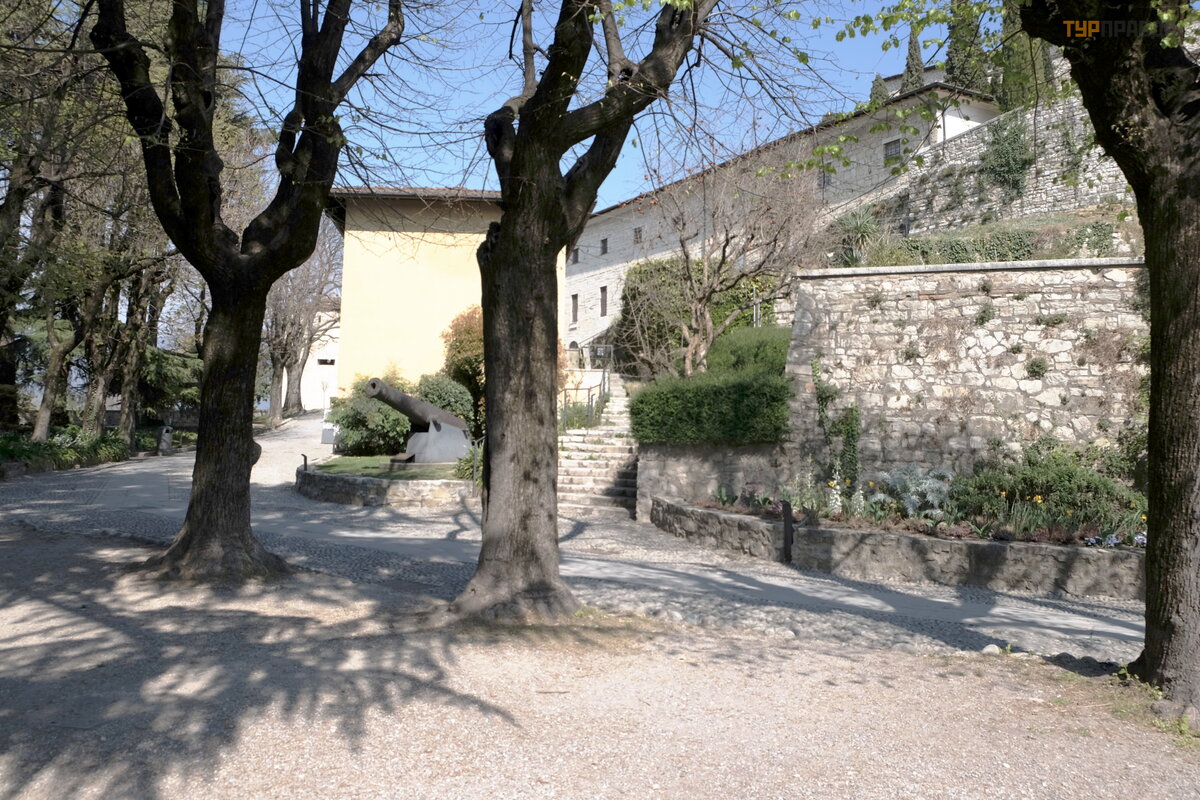
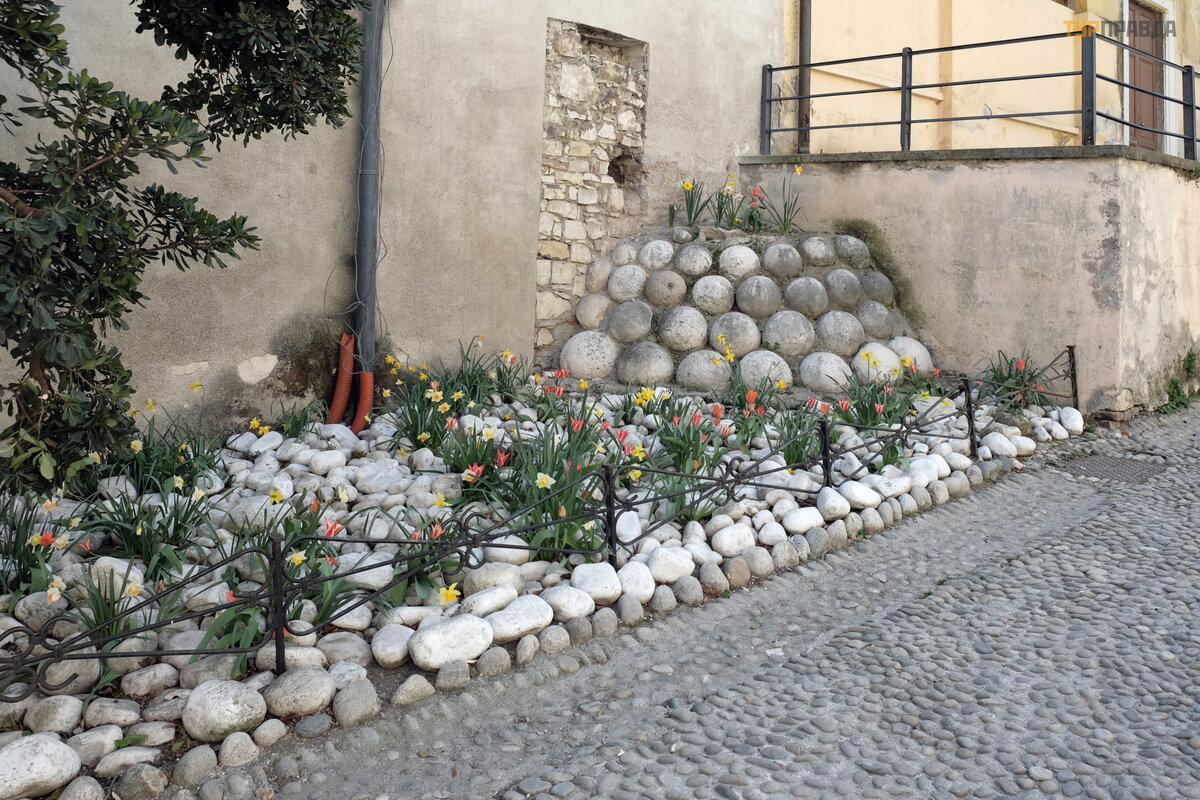
Внутри крепости разбит живописный сквер, где гуляют жители.
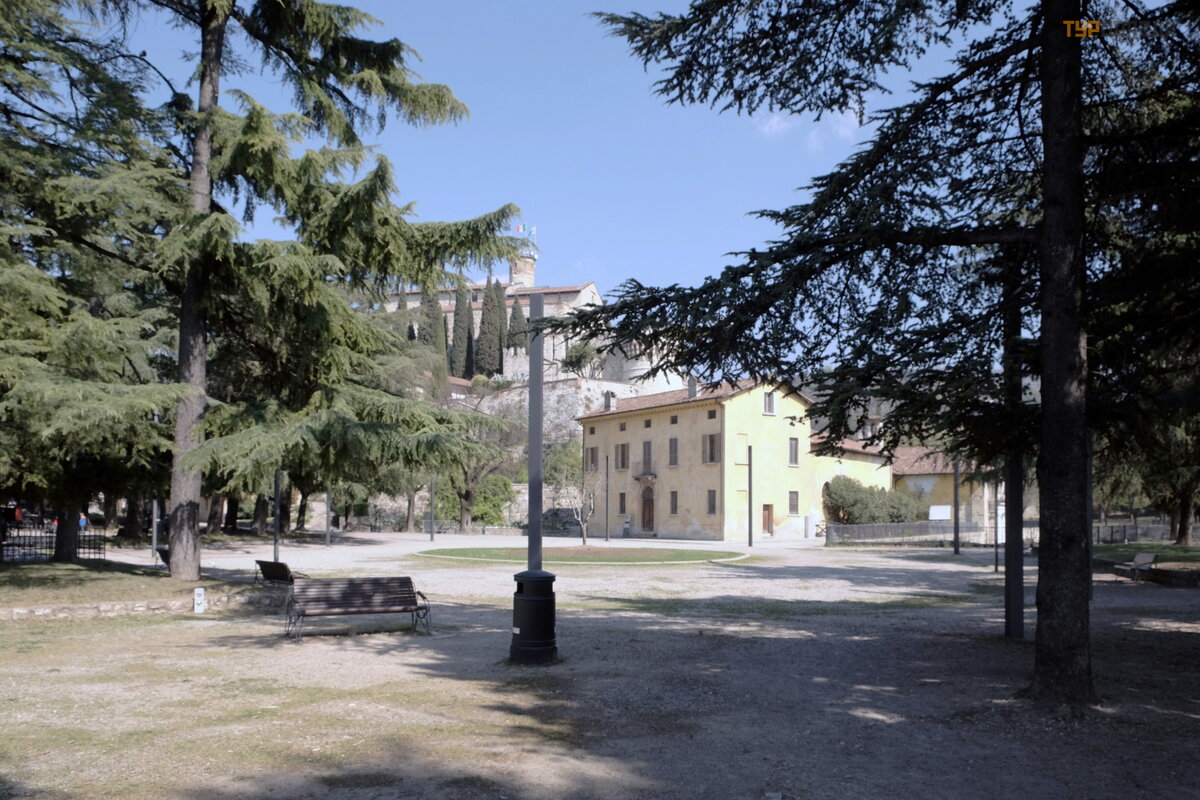
С холма открывается хороший вид на город.
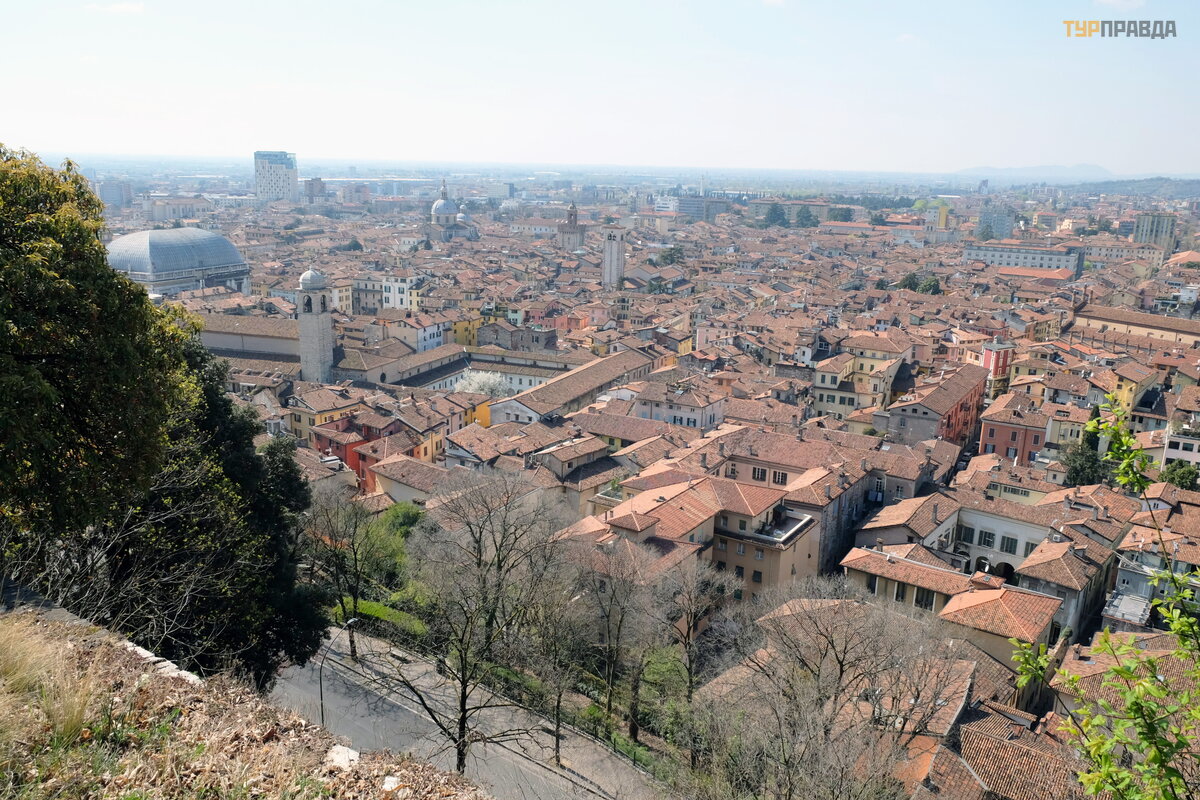
В замке находятся несколько музеев, в которые мы не пошли, а спустившись вниз пошли осматривать еще одну достопримечательность – Римские форумы. Здесь в римские времена был центр общественной и религиозной жизни города, который тогда назывался Brixia. На северной стороне площади сохранилась часть портика с колоннами грандиозного капиталийского храма, возведенного при императоре Веспасиане в 1-ом веке.
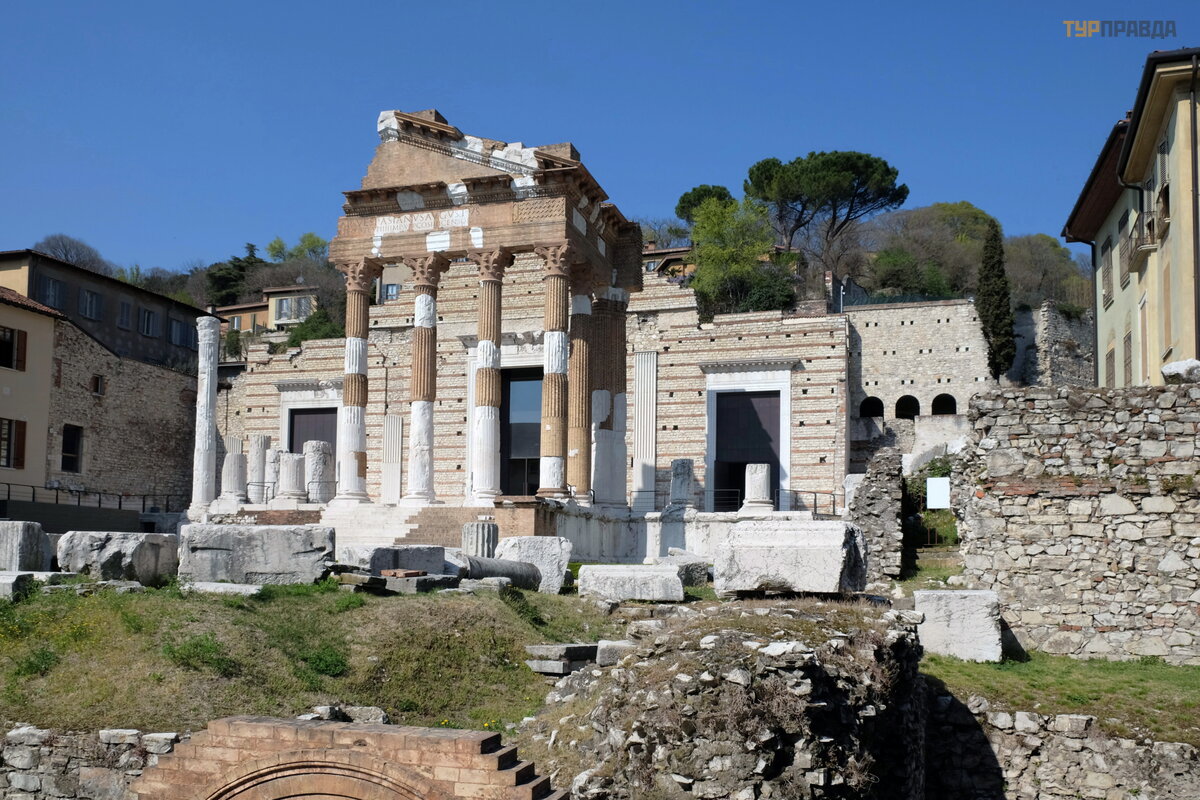
Правее храма находятся руины амфитеатра на 15 тысяч зрителей.
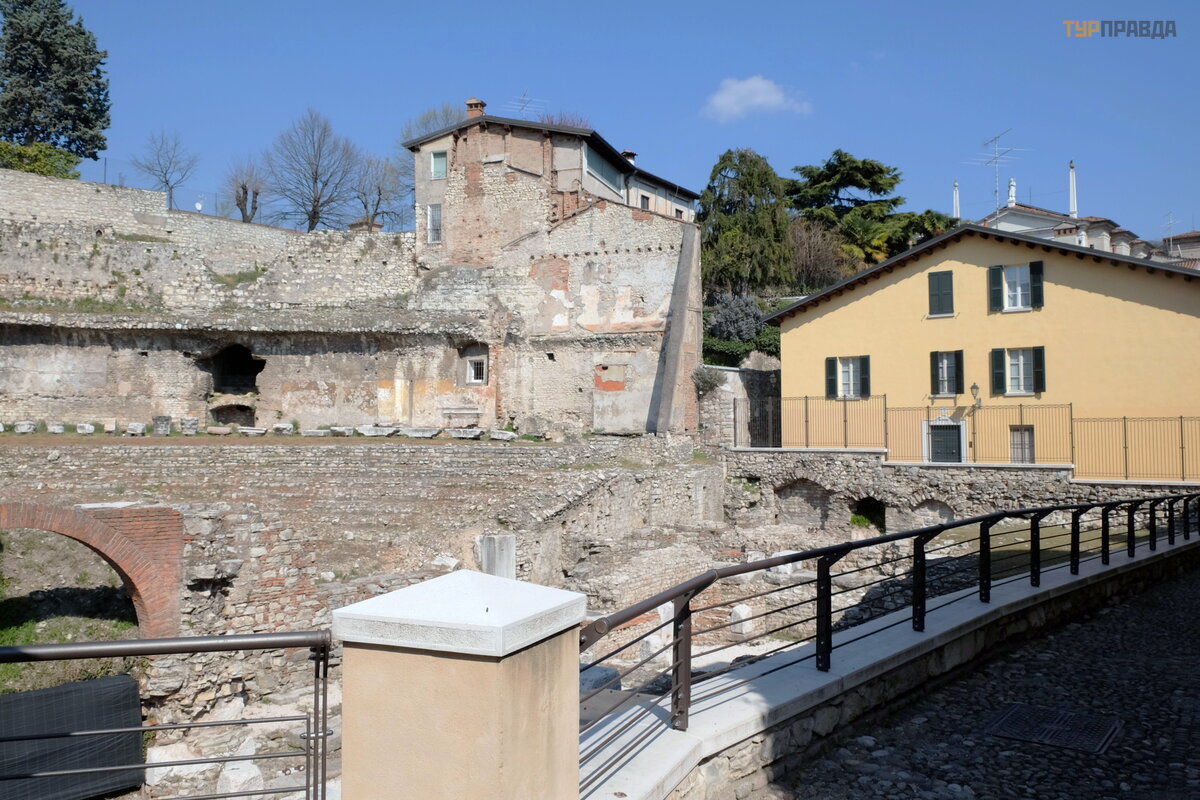
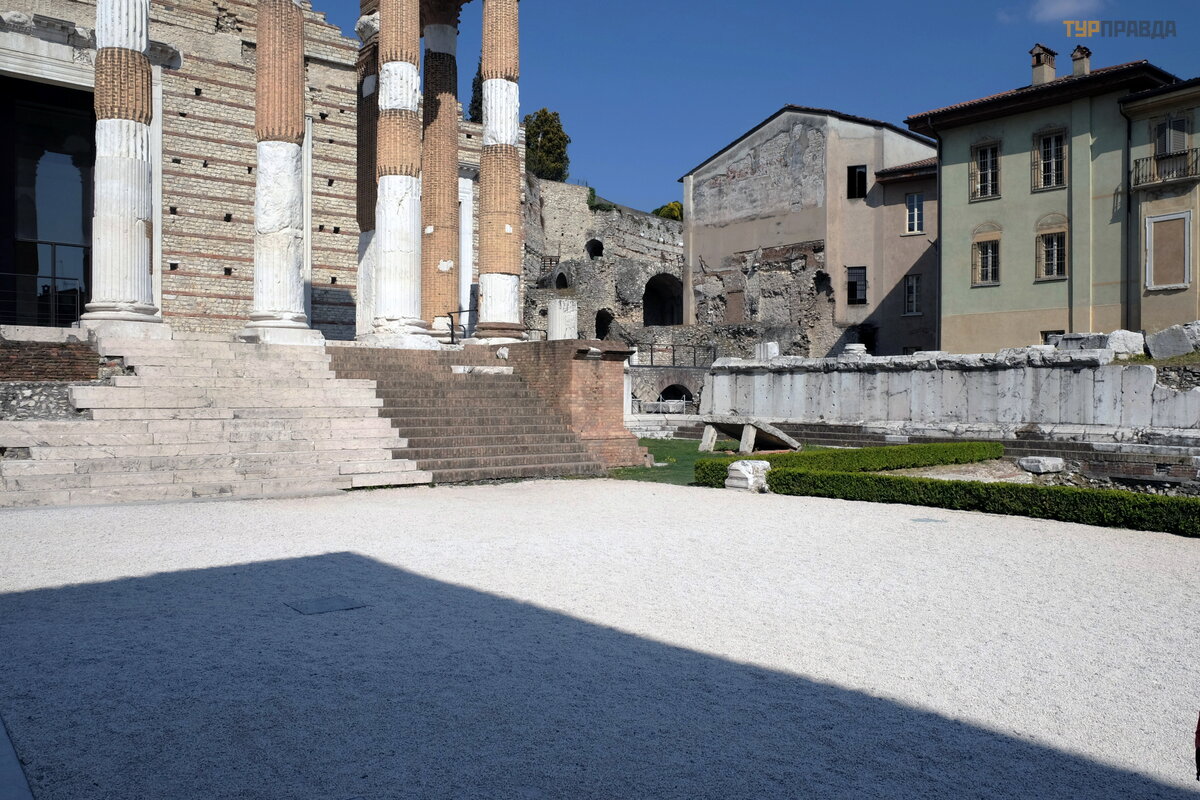
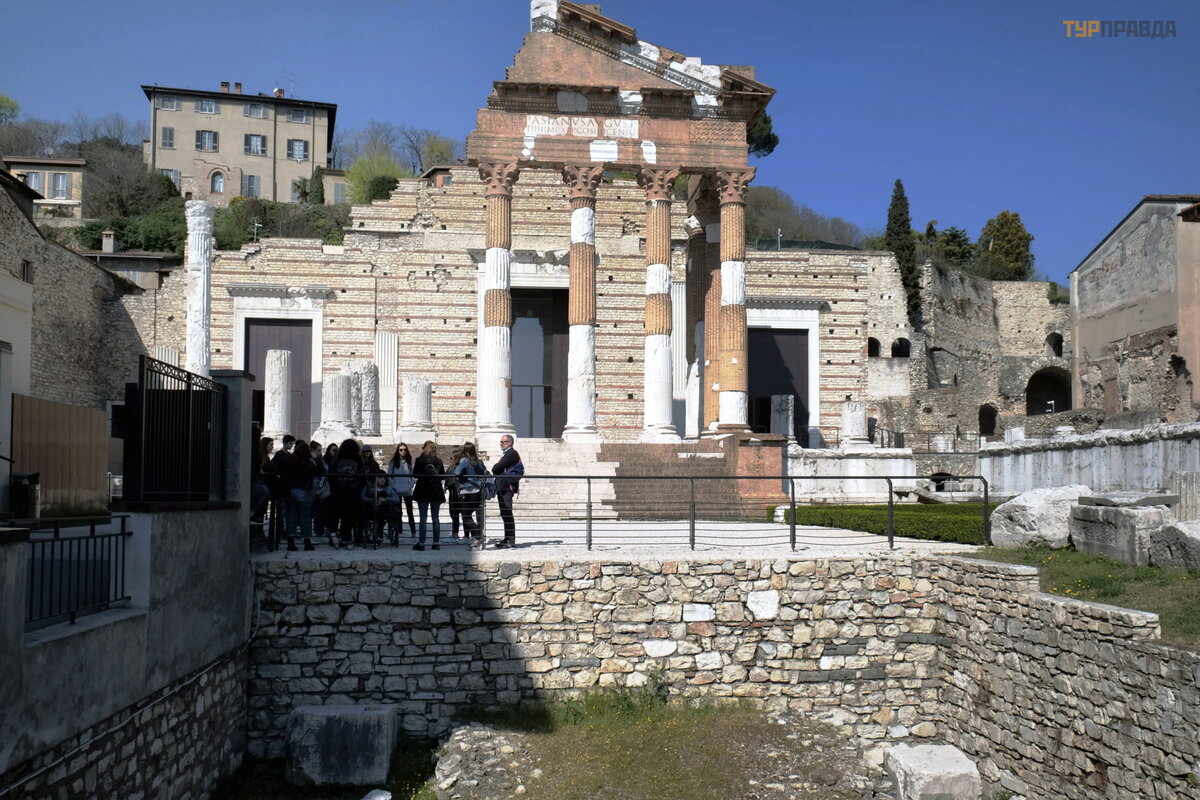
Улица Музеев входит в зону древнеримского города. На перекрестке с этой улицей находится церковь XVIII века Сан-Дзено-аль-Форо (святого Зено на форуме), возведённая на руинах римского форума, но впервые она упоминается уже в XII веке.
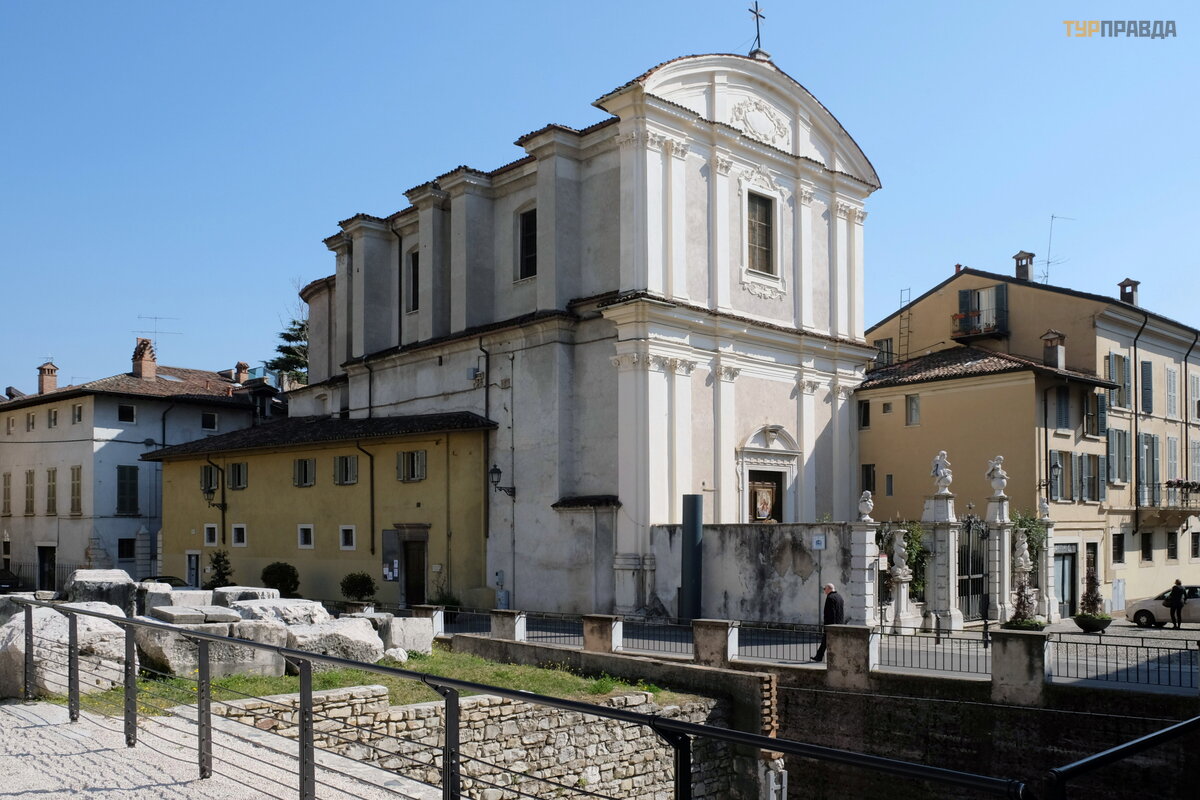
Улица музеев ведет в комплекс музеев Санта-Джулия, где расположена очень красивая церковь Сан-Сальваторе. Как и во многих женских монастырях, главная церковь была открыта для мирян. В сами музеи мы не пошли, а церковь посетили.
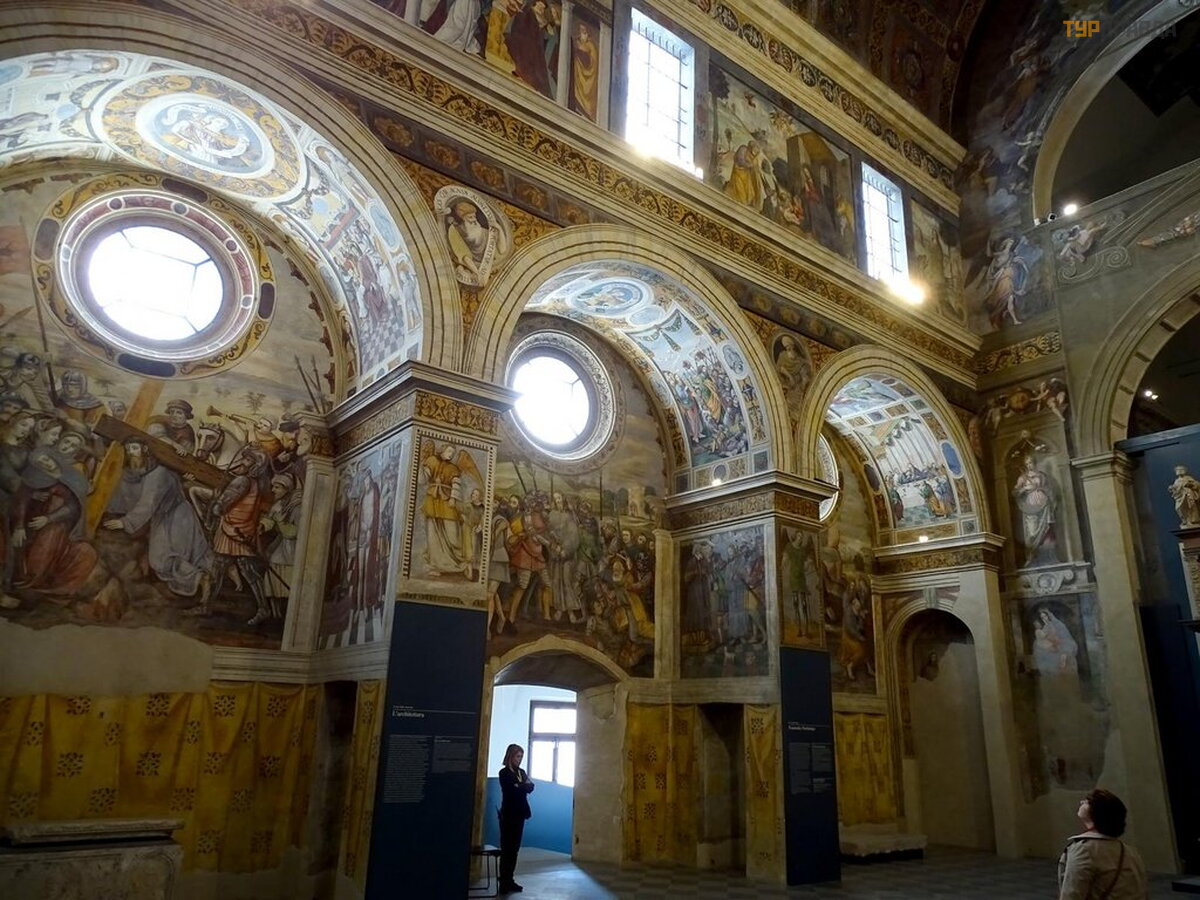
Прекрасный потолок:
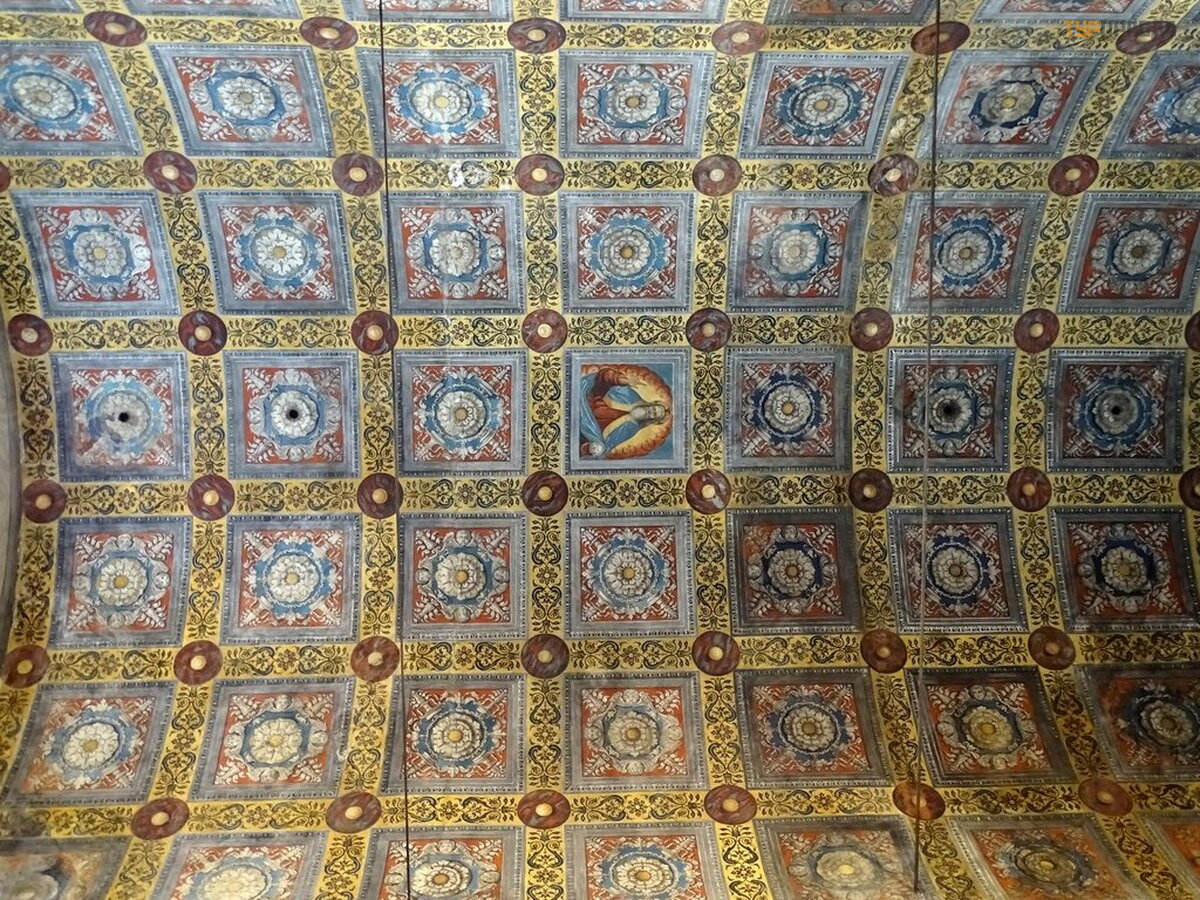
Великолепный мавзолей Мартиненго (исполненный в 1503 г. ):
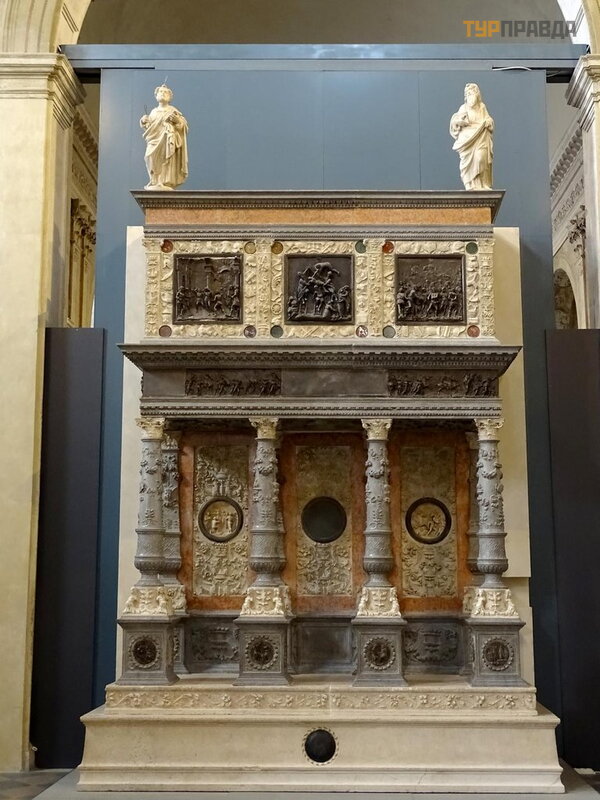
Дальше наш путь лежал обратно, к центру города.
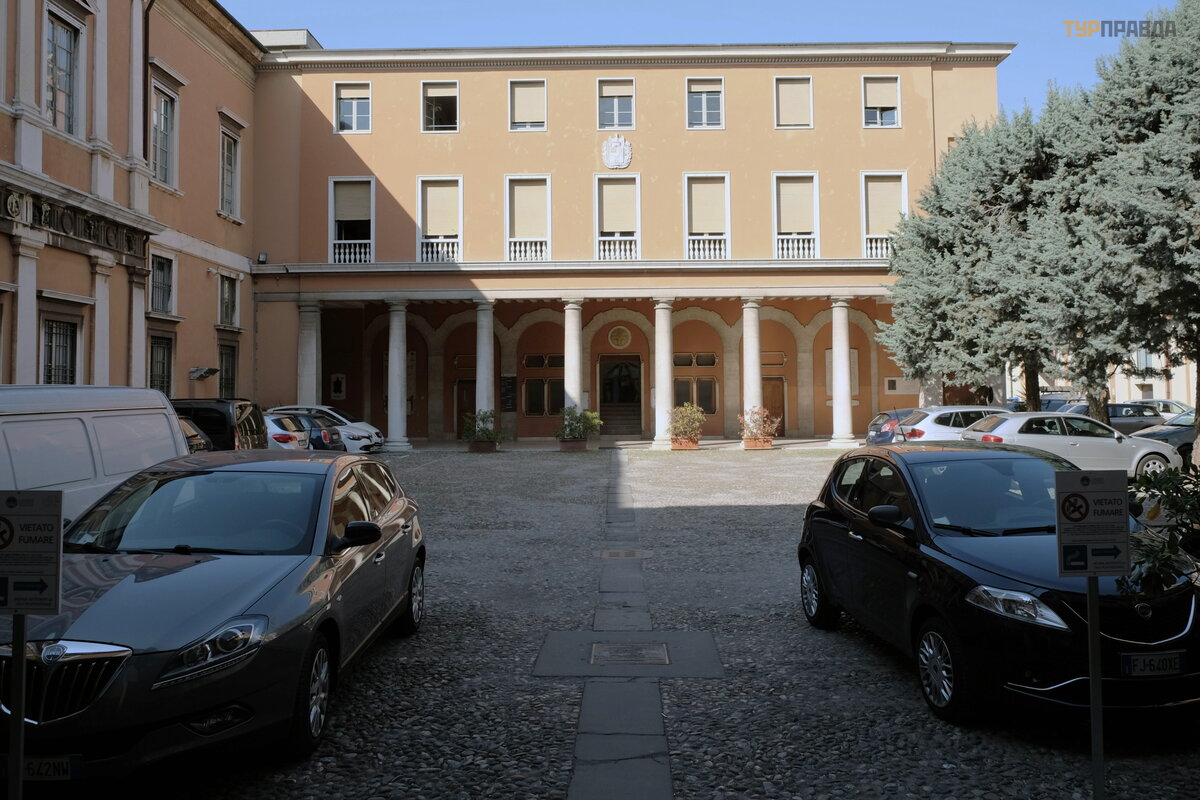
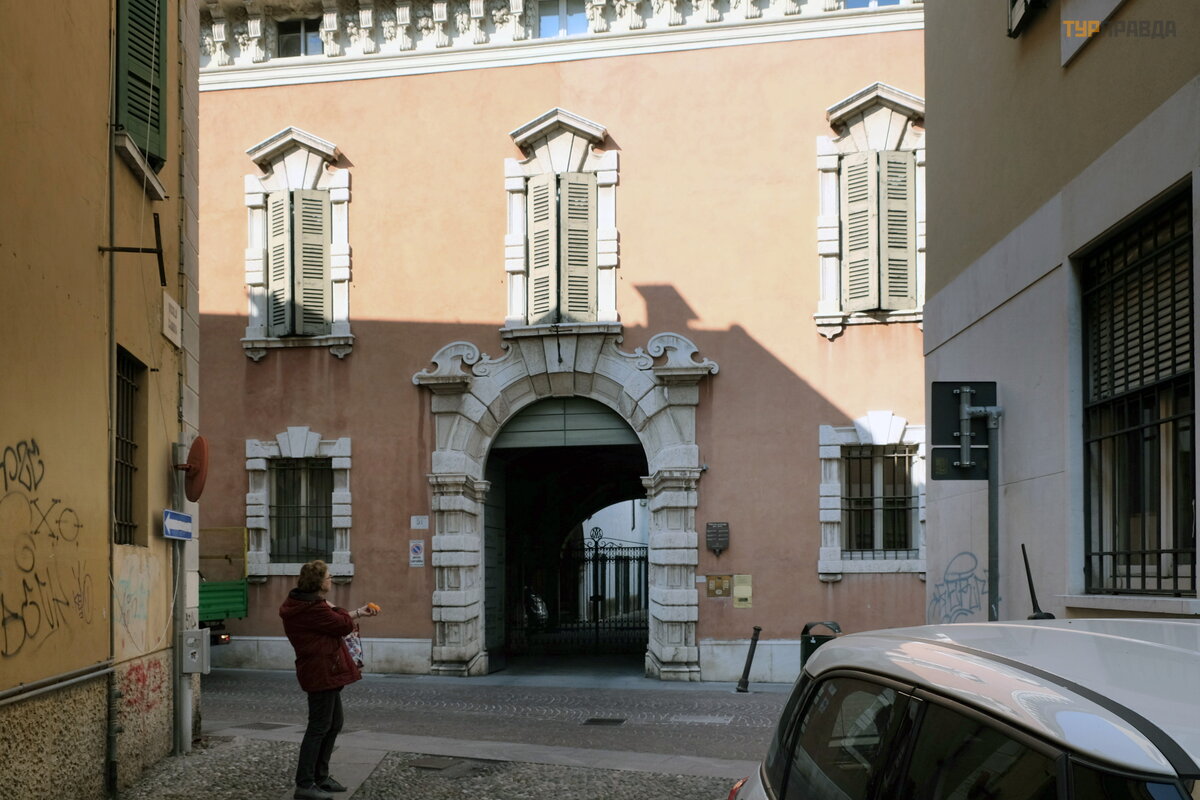
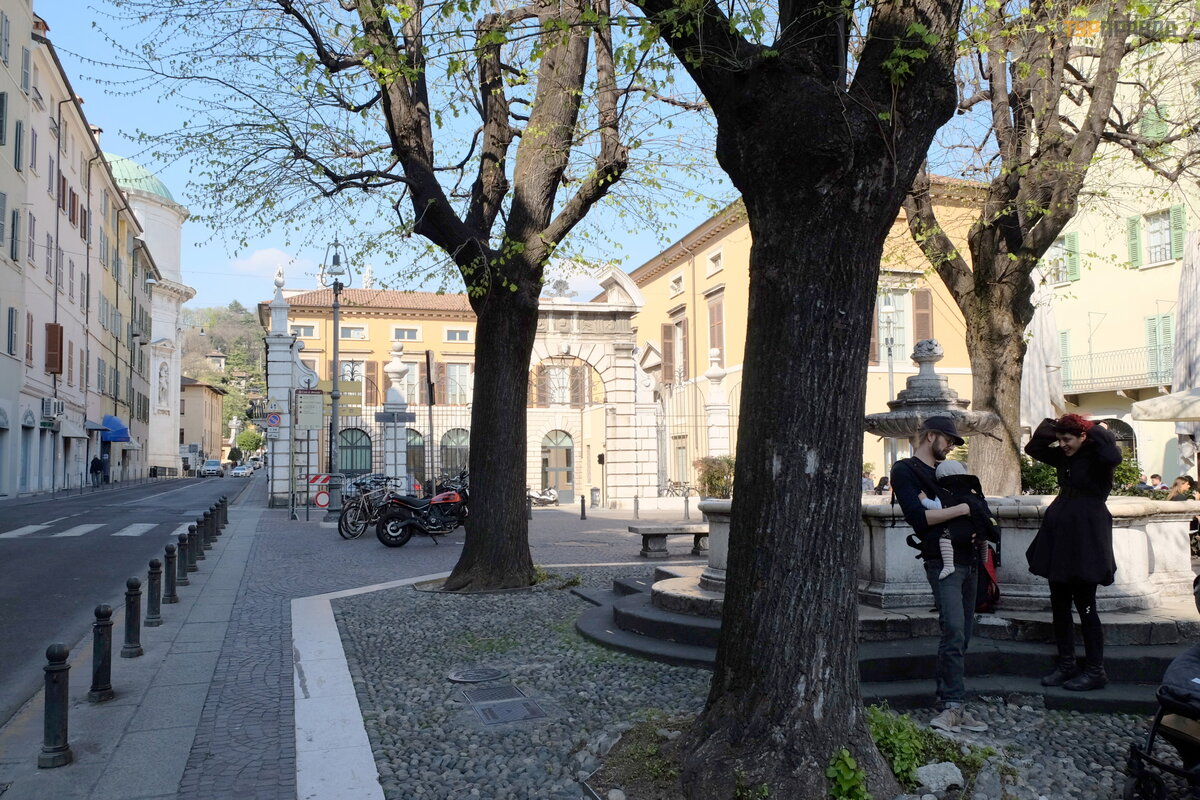
За Палаццо Лоджиа пошли мимо башни Торре делла Паллата – с фонтаном Бьяндоре у подножия (1596 г). Фонтан аллегорически изображает Брешию с ее реками.
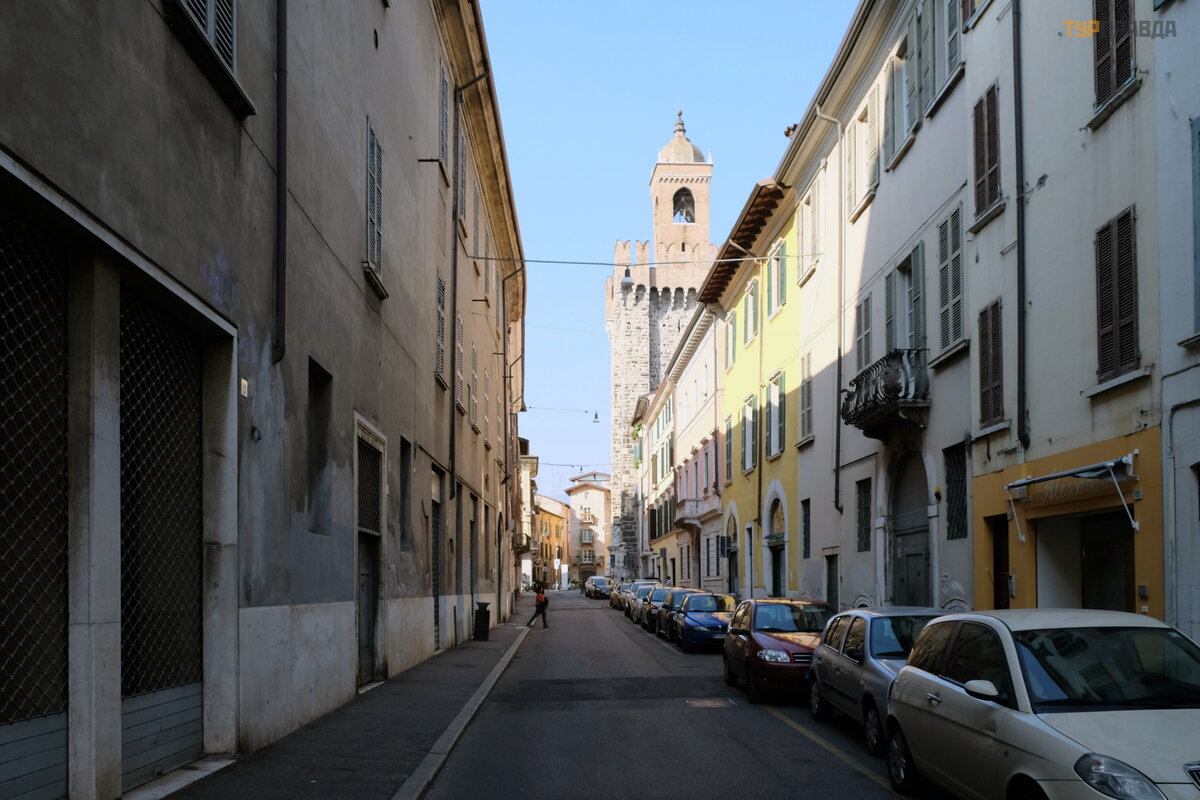
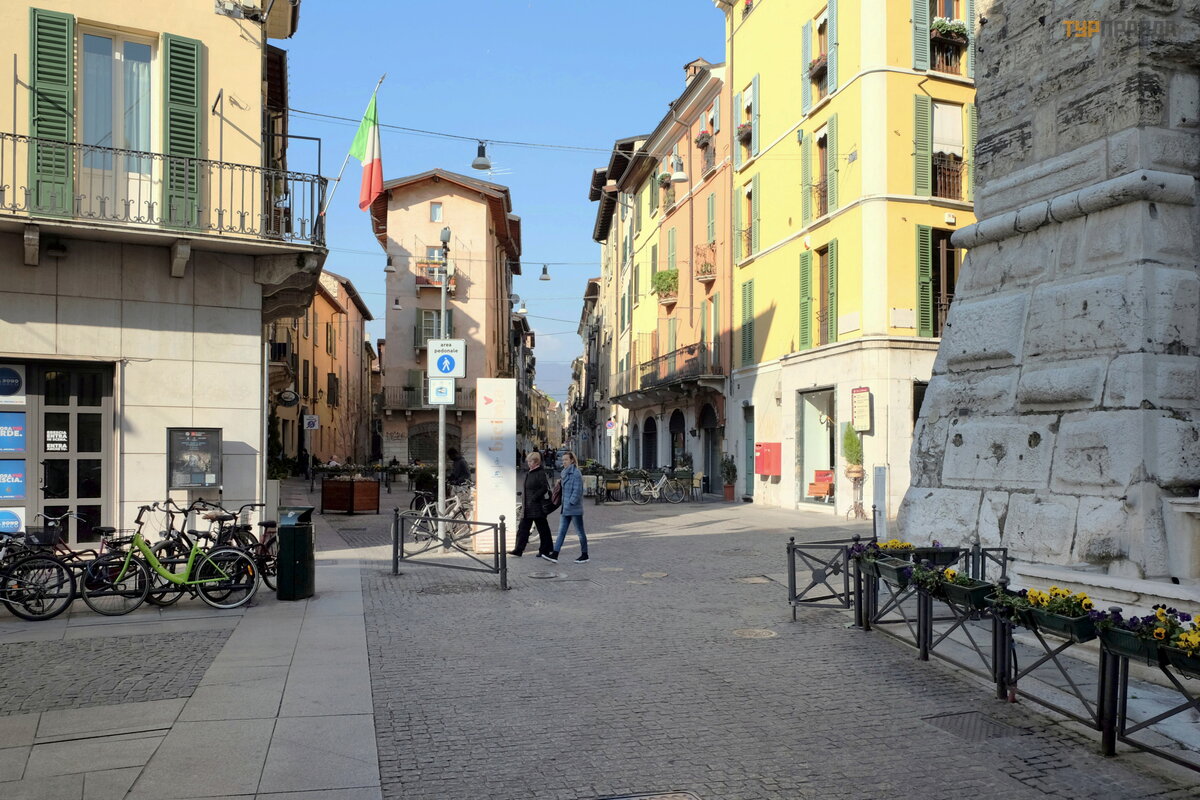
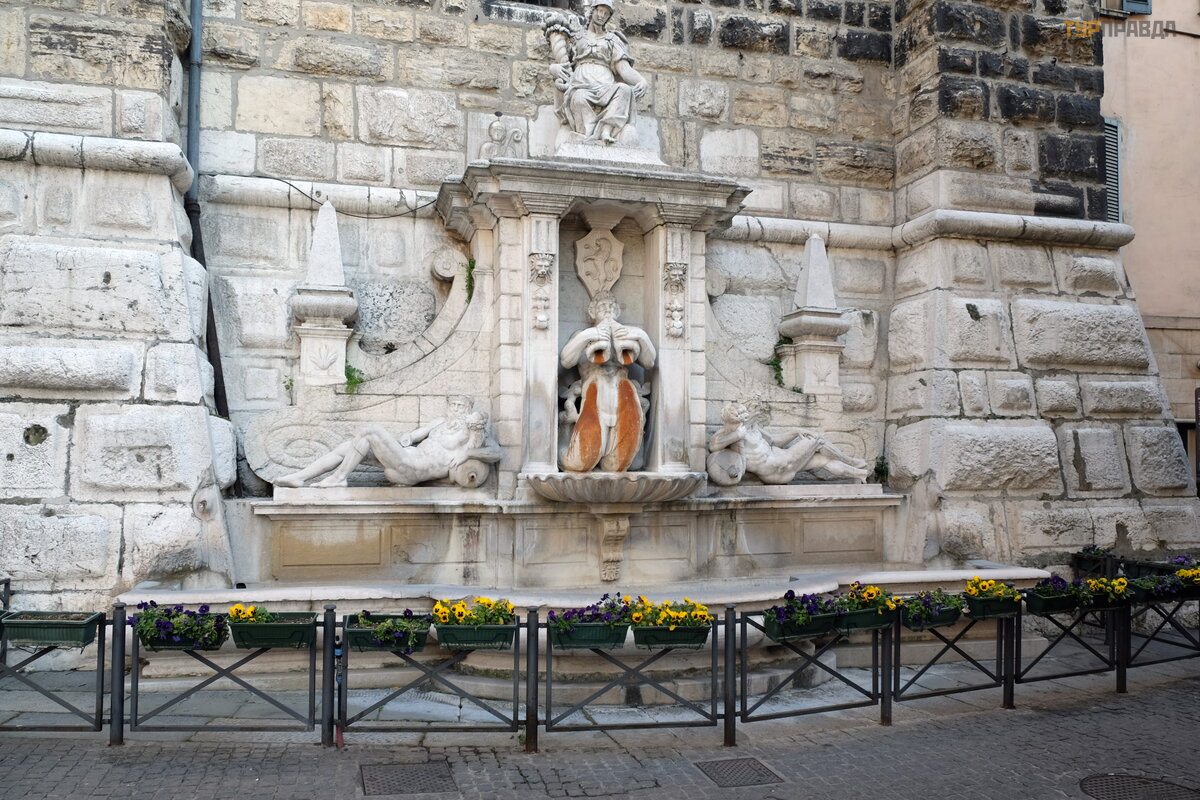
По пути прошли мимо ещё одной примечательной церкви Св. Франциска Ассизского, которая была закрыта.
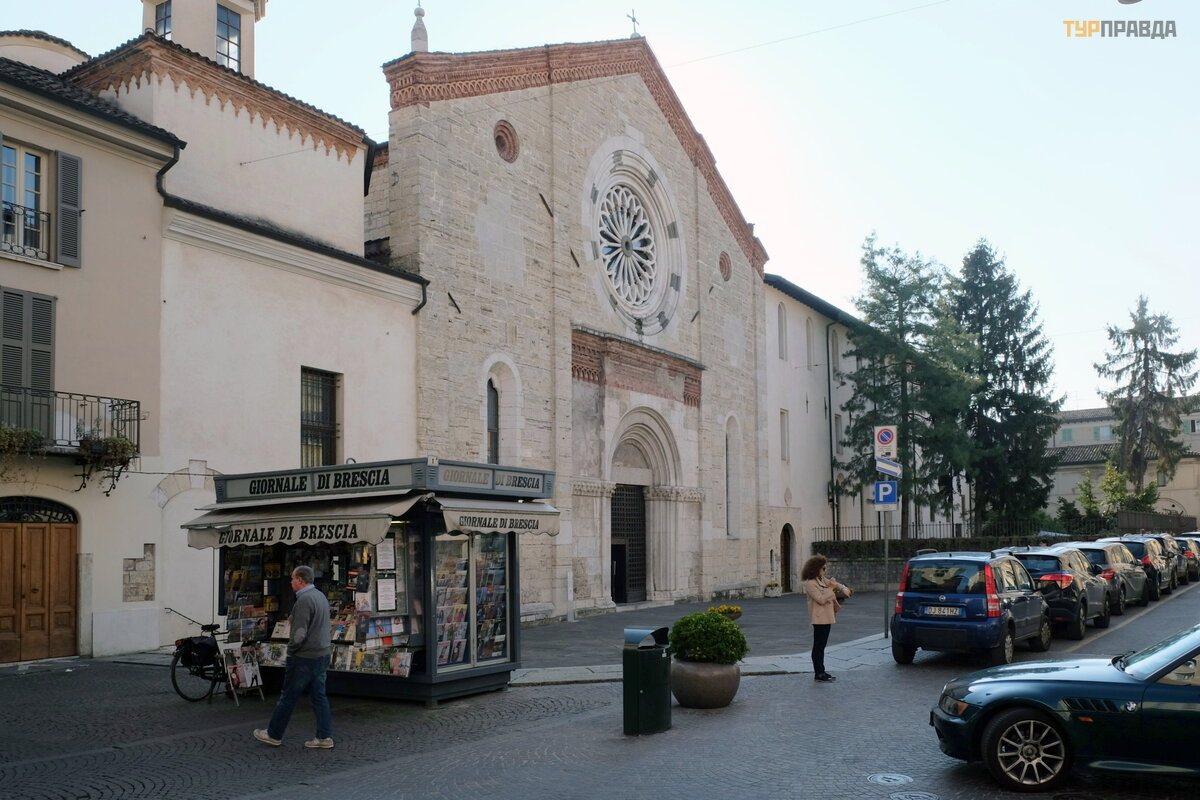
Дальше двинулись к вокзалу. Обязательный Гарибальди:
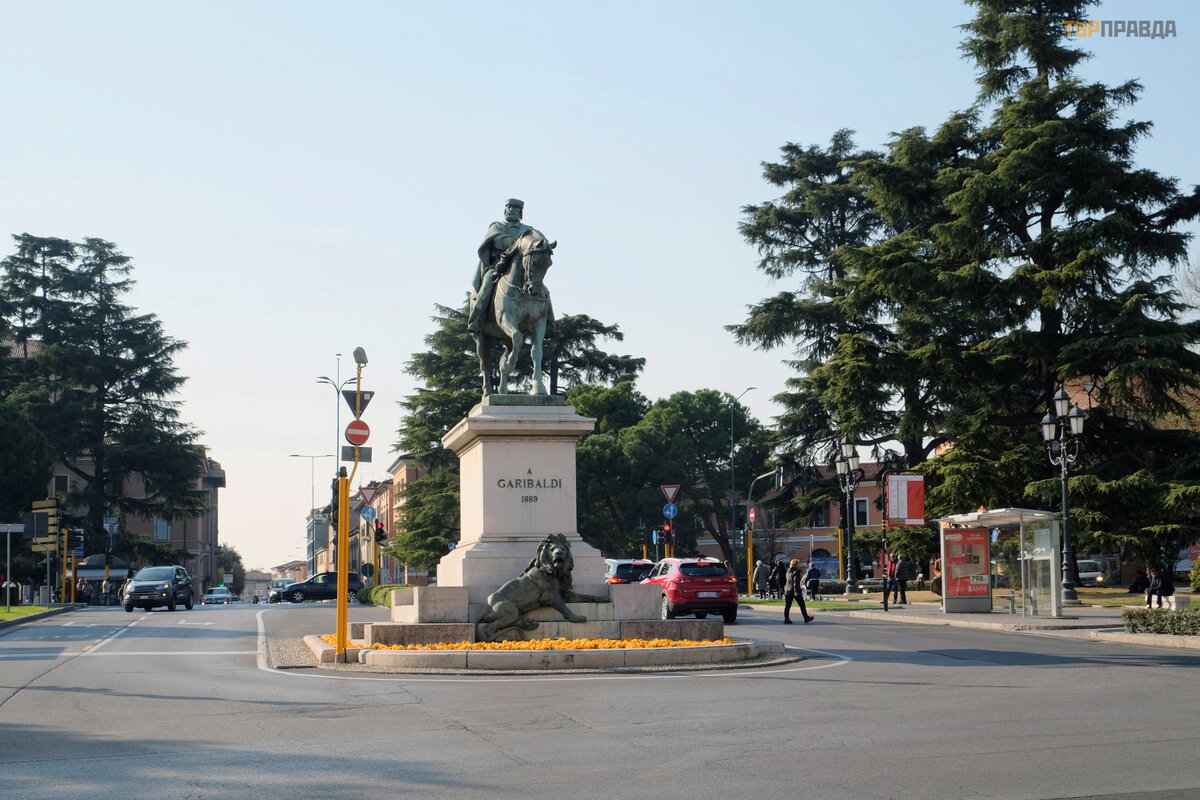
Потом посетили восхитительную церковь Санта Мария деи Мираколи, чей резной беломраморный фасад Черчиль назвал непревзойденным по красоте. В ходе бомбардировок Второй мировой войны интерьер был серьезно поврежден, но затем восстановлен. Любопытно, что фасад церкви тогда практически не пострадал, так как был в деревянных лесах. Фасад делал Джованни Антонио Амадео, автор фасада Чертозы, капеллы Коллеони в Бергамо, миланских Сан-Маурицио и Санта-Мария-прессо-Сан-Сатиро, Дуомо в Павии и много чего еще. К сожалению, сделать хорошее фото резного фасада затруднительно из-за скученной застройки.
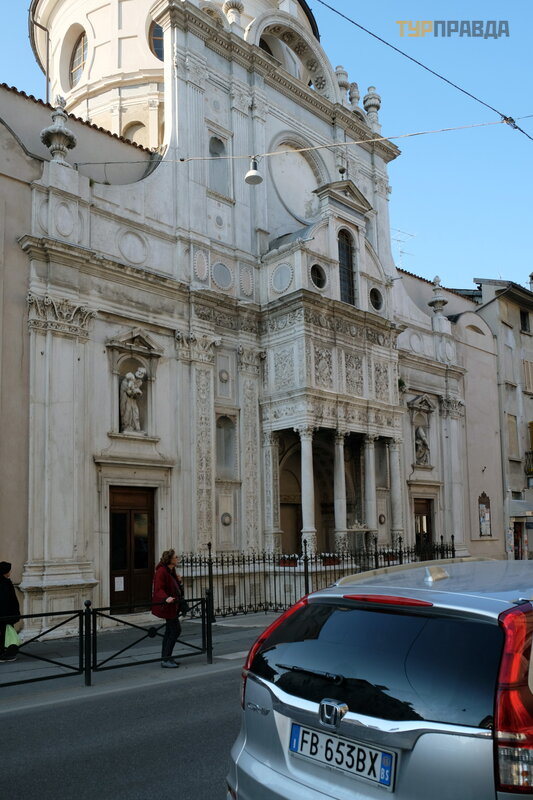
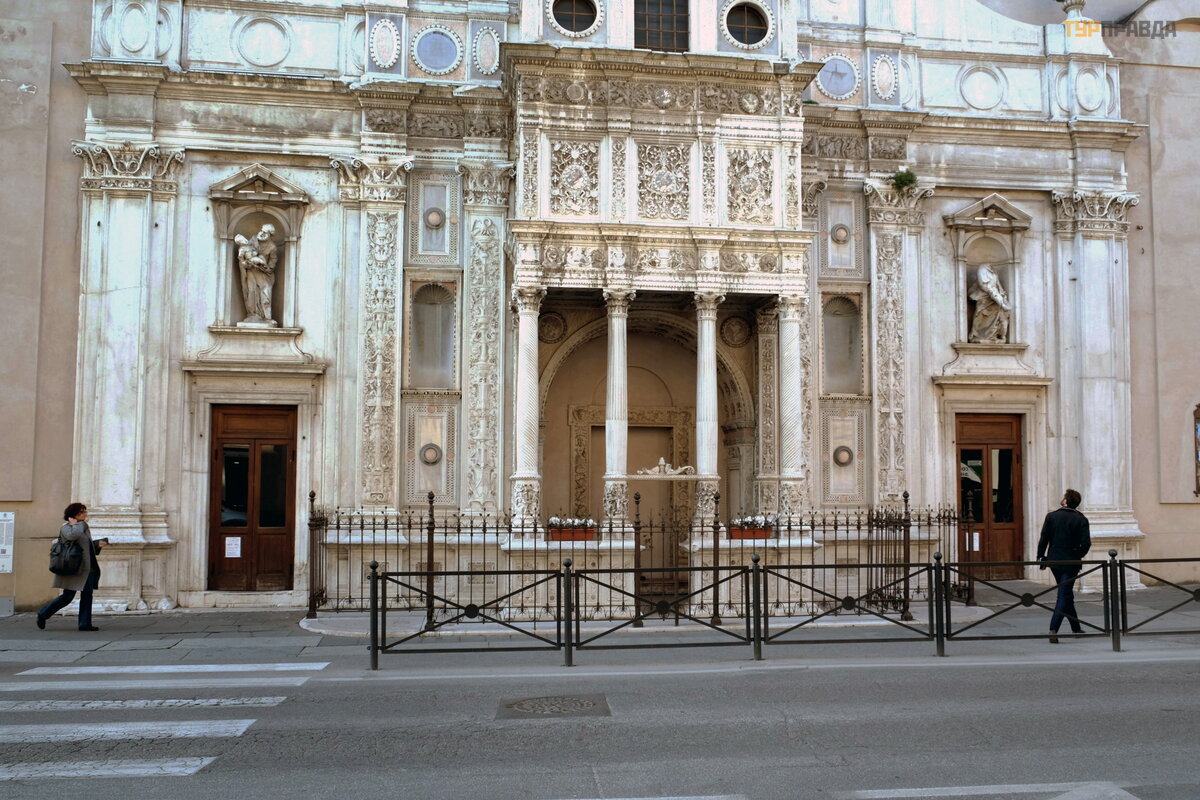
Вот неплохие фото из интернета:
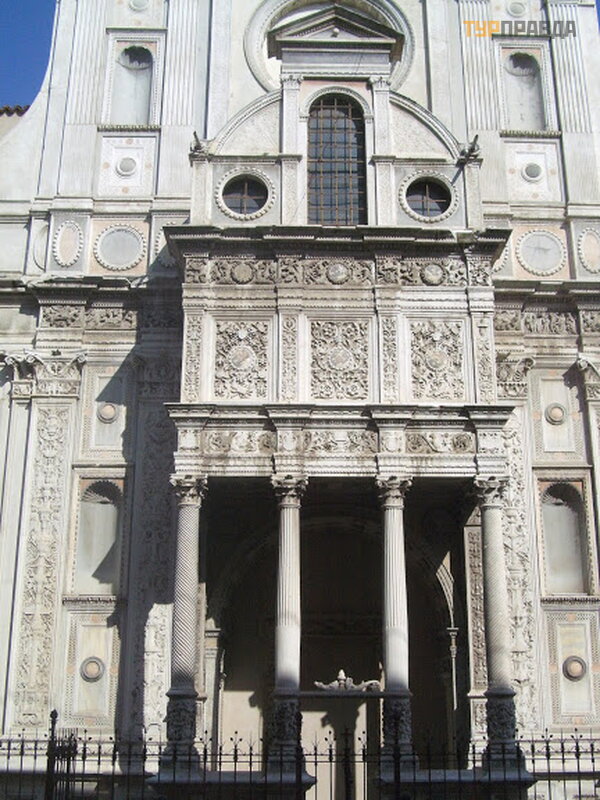
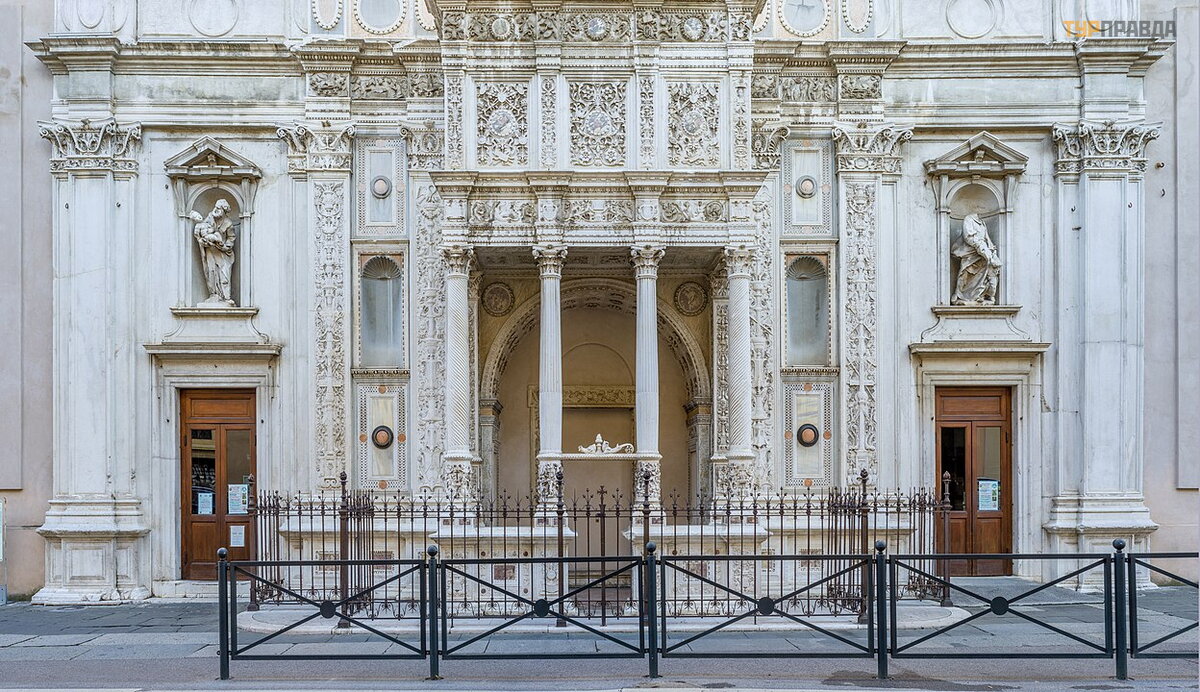
Внимания заслуживает не только фасад церкви, но и её великолепный интерьер, в создании которого участвовали итальянские скульпторы и художники XV-XVII веков: Гаспаро Коирано, Пьетро Мария Баньядоре, Моретто и другие.
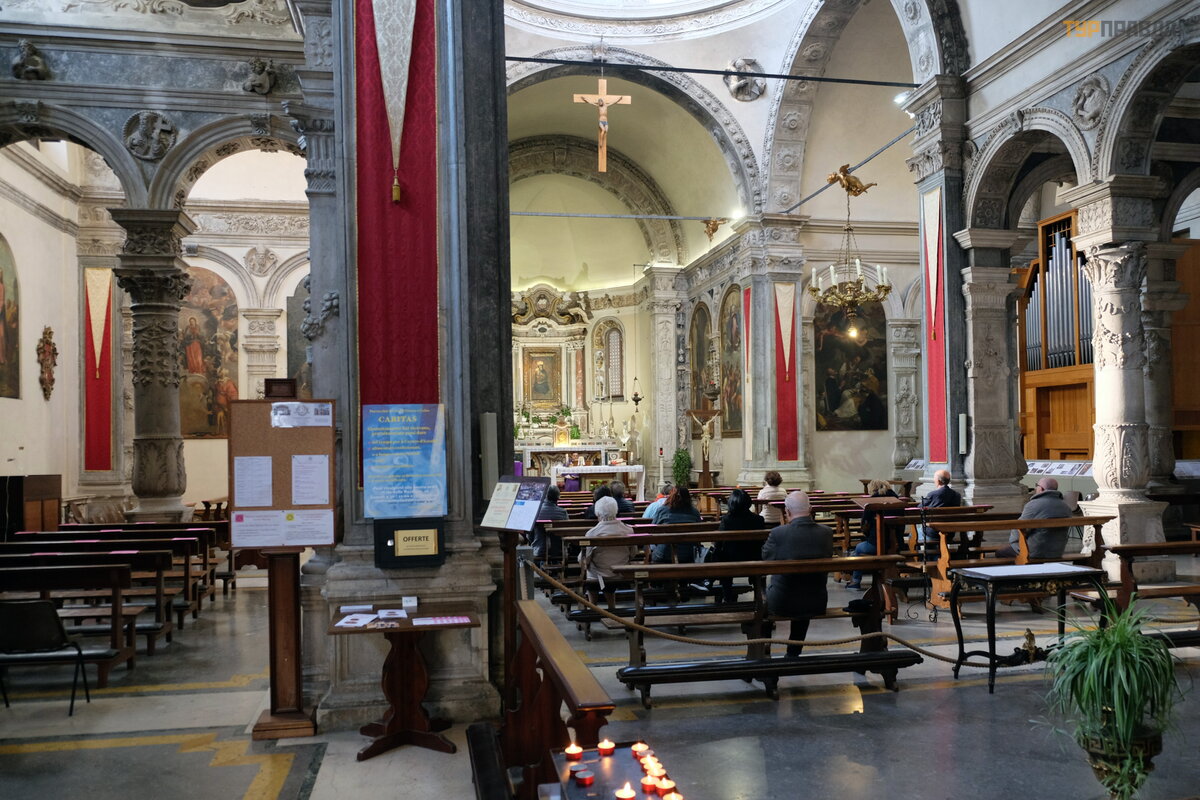
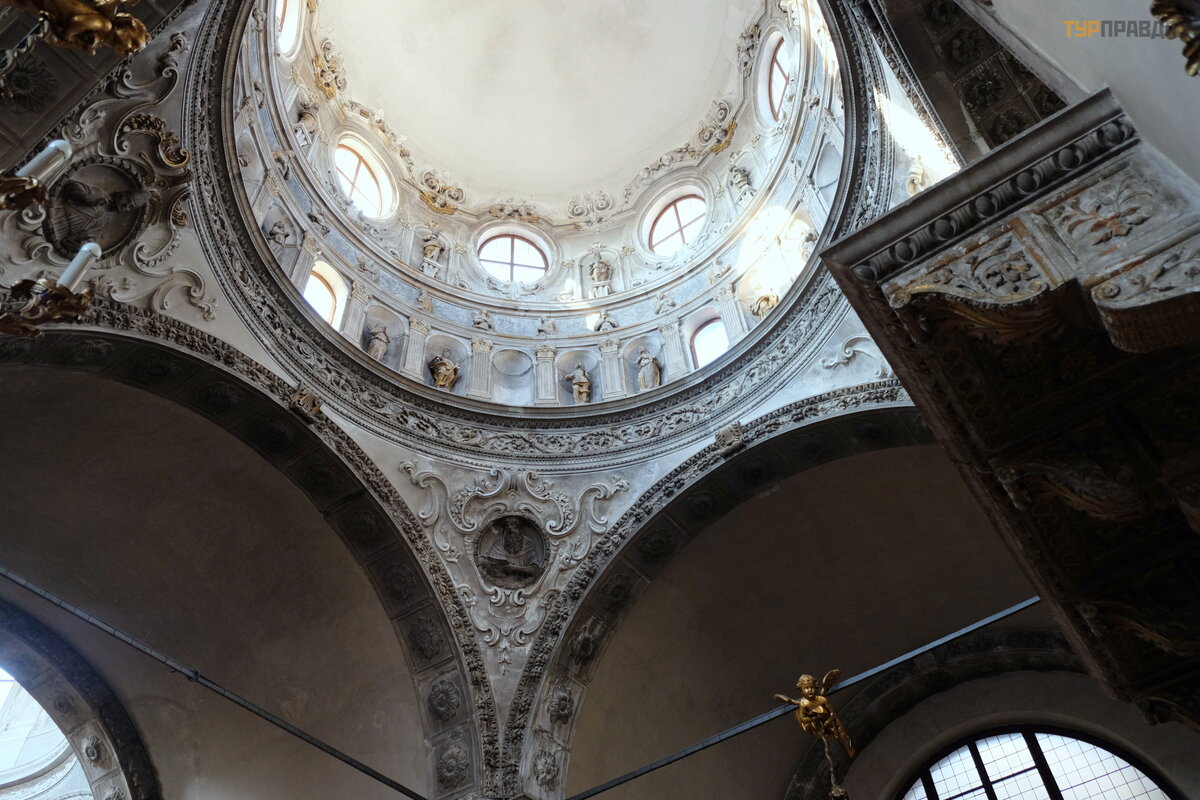
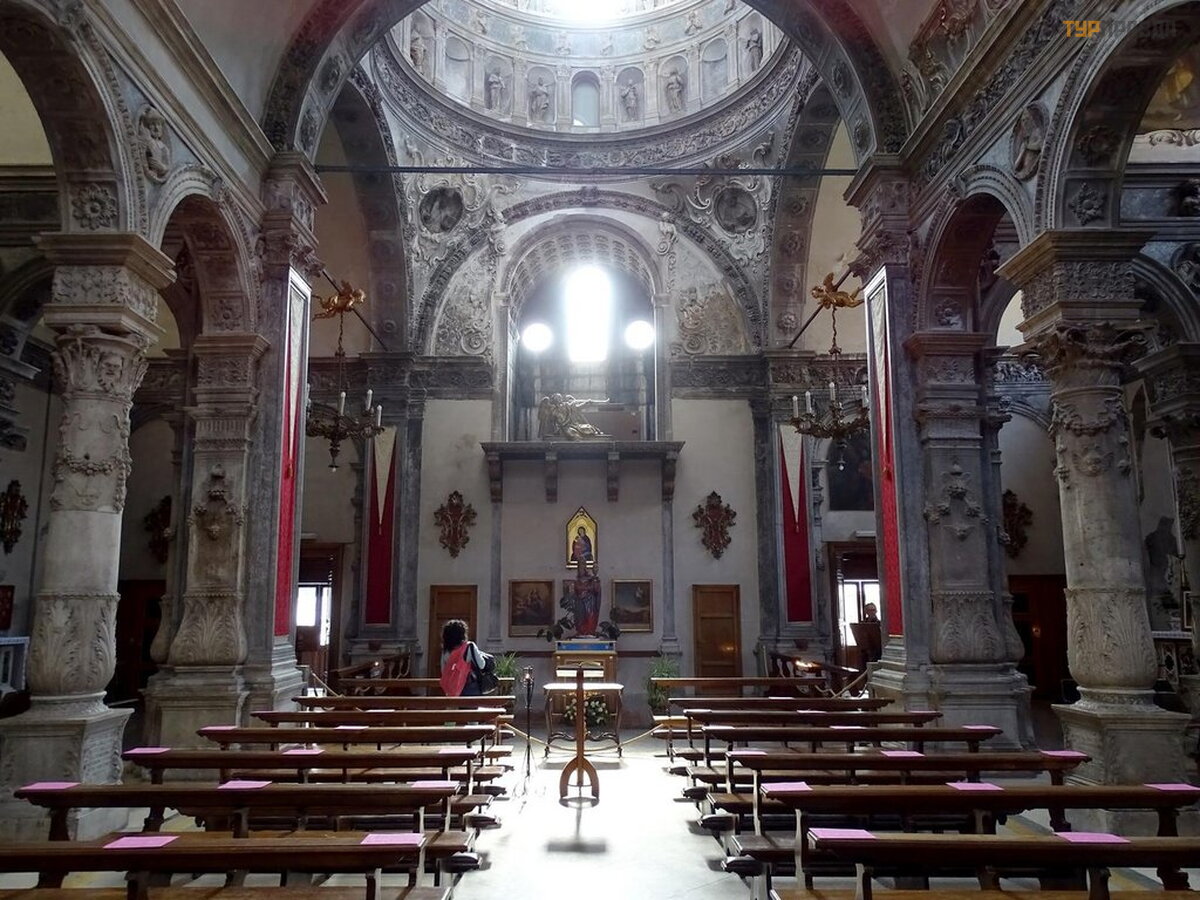
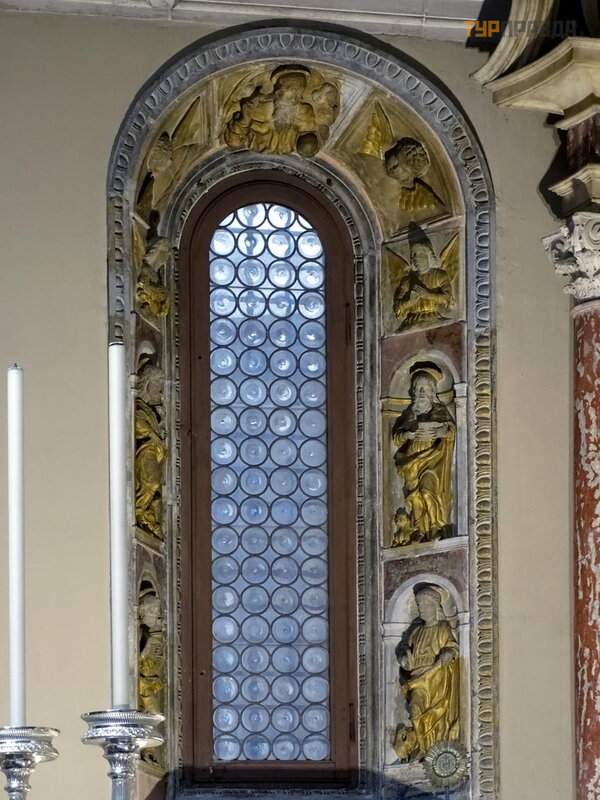
Наше путешествие в Брешию закончилось, город очень понравился, переходишь как в машине времени из эпохи в эпоху. Всем советую побывать.
Весеннее путешествие по Италии. Часть 4. Тревизо > > >
A spring trip to Italy. Part 1. Trento >>>
A spring trip to Italy. Part 2. Mantova >>>
The third day was devoted to the city of Brescia, the second largest city in Lombardy. It takes about an hour to get from Verona by train, on the way we pass by a very beautiful Lake Garda, a lot of passengers got off there, but since we once were on the Garda in the city of Sermiola, we proceeded further.
Brescia lies away from the tourist routes, but in vain. Brescia is world famous for its industry, trade and agriculture. At the same time, it is a captivating city, rich in historical past, works of art and architectural monuments, some of which are included in the UNESCO World Heritage List. This is an ancient city founded 3200 years ago.
The city is quite large, there is a subway line. From the station we went to the information center,
took a map and moved to the city center.



Let's go to the square in front of the Cathedral.
Piazza Duomo is a magnificent historical square that is the heart of Brescia. This urban space is surrounded by old buildings with cozy street cafes.
Since 1963, the square has been called Piazza Paolo VI. Pope Paolo VI, in the world - Giovanni Battista Enrico Antonio Maria Montini - a native of Brescia.
There are three iconic sights here at once:
The New Cathedral is a beautiful 17th century baroque and rococo church with a massive central dome added in 1825. The Old Cathedral is an ancient Romanesque rotunda that dates back to the 11th and 12th centuries. Under the cathedral is a crypt built in the 9th-11th centuries as part of an even older basilica. Broletto is an old medieval town hall from the 12th century with a square Poncarali tower added 100 years later. The height of the tower is 91 meters. 

There are two fountains from the 18th century in the center of the square.
On the north side, by the Palazzo Broletto, there is a fountain with a copy of the neoclassical statue of Minerva. This is the work of Giambattista Giambattista Cignaroli 1818. It was installed here in 1921.

Old Cathedral, which is a fine example of Romanesque architecture. For its rounded shape, the Cathedral is also called the Rotunda. He also has another name, the official one is Santa Maria Asunta (Concattedrale invernale di Santa Maria Assunta). It was built at the end of the 11th century on the site of an even older church of the 7th century Santa Maria Maggiore, which, in turn, was erected on the site of an ancient basilica of the 4th-5th century. These are the historical layers.


The cathedral houses the marble sarcophagus of Bernardo Maggi, Bishop of Brescia, who put an end to the war between the Ghibellines and the Guelphs. “Packed” in a magnificent Verona red marble sarcophagus.
Interesting frescoes are partly preserved in the interior. Also here is the crypt of one of the earliest Christian shepherds of the 4th century.


The walls and the dome were painted by the artist Moretto da Brescia. His frescoes "The Evangelists Luke and Mark", "Elijah and the Angel" became recognized works of medieval art.



The construction of the new cathedral (the summer cathedral of Santa Maria Assunta) began in the 17th century and was completed in the early 19th. During the construction process, the project of Andrea Palladio, the founder of the classical style, was used. As a result, the building turned out to be of mixed styles - neoclassicism and baroque.

The cathedral is crowned with an impressive turquoise dome, which is visible from many points of the city. The cathedral in Brescia in height (91 m) is the third in Italy - after the cathedrals of St. Peter in Rome and Santa Maria del Fiore in Florence.

Inside the grave of Pope Paolo VI. The work of the contemporary sculptor Raffaele Scorzelli, 1984.

The inside of the cathedral was painted by the artists of Brescia - Moretto and Jacopo Palma Jr.
Altarpiece by Rodolfo Vantini with painting by Moretto da Brescia "The Sacrifice of Isaac".

The altar is on the right. It includes the monumental ark of Saint Apollonius, adorned with exquisite bas-reliefs and remarkable Renaissance sculptures by Gasparo Cairano (1508-1510).

After seeing the cathedrals, we moved on to another very interesting square - Piazza Vittoria(Victory Square).

The square was built in the neoclassical style by the chief architect of the Mussolini era, Marcello Piacentini. The architect created a very harmonious ensemble by 1932, the square was dedicated to the tenth anniversary of the establishment of Mussolini's fascist dictatorship. The area is surrounded by public palaces. The central building is the Postal Palace.
White Marble Tower of the Revolution with a clock - all sorts of councils and institutions.




The first concrete skyscraper in Italy with 13 floors.

The palaces were richly decorated with reliefs depicting various cultural events and heroes of the Brescian history. Ancient Vittoria Alata, Saints Faustino and Giovita, patrons of the city, as well as famous artists and heroes of the First World War, and, of course, the heroes of fascism, along with Benito Mussolini himself.
But Mussolini and the Fascists disappeared from the reliefs after 1945. At the foot of the Revolution Tower there is an impressive marble tribune - the place of Mussolini's public speeches.
After a short passage, we moved to another remarkable square, already medieval - Loggia Square (Piazza della Loggia). The area began to be built up in the middle of the 15th century at the time of the entry of Brescia into the Venetian kingdom. Renaissance buildings lined the perimeter.

The main building on the square is the Palazzo Loggia, which now houses the Brescia City Hall.

On the opposite side is a building with an arcade and the Orolodgio clock tower.

In 1864, the sculpture of the Beauty of Italy (Monumento alla Bella Italia) was installed, dedicated to the ten-day uprising against the Austrians in 1849.

After going around the Palazzo Loggia, we go towards the Cidney Castle (correctly in Italian - Chidneo), towering over the city.


The path to the fortress begins directly from Tito Speri Square, named after the hero of the Italian Wars of Independence from Austria in 1848-1849. There is a monument to Tito Speri on the square.

Nearby is the Church of Santa Maria della Carita (Saint Mary of Mercy).

The church was built in 1640 according to the project of Agostino Avanzo on the site of an early 16th-century monastery, in which repentant fallen women found shelter. The rich interior decoration was completed in 1755. Incredibly beautiful altar and floor of colored marble.



Then we went astray, for some reason we thought
that the entrance to the castle is on the other side of the tunnel.

But I had to turn back.

Then we only went up.



Finally, the road leads to a bridge over the moat, which leads to a gate (16th century) into the fortress. The gates are decorated with a winged lion, the symbol of the Republic of Venice.

The oldest part of the castle is the Mirabella cylindrical tower, built on foundations from the late Roman period in the 12th and 13th centuries. In the 14th century, the existing structures were expanded, a donjon and two towers were built, and battlements were strengthened.
It is interesting that in April 1799, when Brescia was occupied by Napoleonic troops,
the castle was besieged by the Russian-Austrian army under the command of Suvorov. After several hours of shelling, the French garrison surrendered.
We pass through the moat and get into the territory of the fortress-castle, which turns out to be huge, with numerous bastions, towers, passages, tunnels. Entrance to the castle is free.




Inside the fortress there is a picturesque square where residents walk.

There is a good view of the city from the hill.

There are several museums in the castle, which we did not go to, but going downstairs we went to see another attraction - the Roman Forums.
Here in Roman times was the center of the social and religious life of the city, which was then called Brixia. On the northern side of the square, a part of the portico with columns of the grandiose capitalist temple, erected under the emperor Vespasian in the 1st century, has been preserved.

To the right of the temple are the ruins of an amphitheater for 15.000 spectators.



Museum Street is part of the area of the ancient Roman city. At the crossroads of this street is the 18th century church of San Zeno al Foro (Saint Zeno in the Forum), built on the ruins of the Roman Forum, but it was first mentioned in the 12th century.

The Museum Street leads to the Santa Giulia Museum Complex, where the very beautiful Church of San Salvatore is located.
Like many convents, the main church was open to the laity. We did not go to the museums themselves, but visited the church.

Beautiful ceiling:

The magnificent mausoleum of Martinengo (executed in 1503):

Further on, our path lay back to the city center.



For the Palazzo Loggia we went past the Torre della Pallata tower - with the Biandore fountain at the foot (1596). The fountain allegorically depicts Brescia with its rivers.



On the way we passed by another remarkable church of St. Francis of Assisi, which was closed.

Then we moved to the station. Mandatory Garibaldi:

Then we visited the amazing church of Santa Maria dei Miracoli, whose carved white marble facade Churchill called unsurpassed in beauty. During the bombing of World War II, the interior was seriously damaged, but then restored. It is curious that the facade of the church then practically did not suffer, as it was in wooden scaffolding. The facade was made by Giovanni Antonio Amadeo, the author of the Certosa facade, the Colleoni Chapel in Bergamo, Milan's San Maurizio and Santa Maria presso San Satiro, the Duomo in Pavia and much more. Unfortunately, it is difficult to take a good photo of the carved facade due to the crowded buildings.


Here are some good photos from the Internet:


Not only the facade of the church deserves attention, but also its magnificent interior, which was created by Italian sculptors and artists of the 15th-17th centuries: Gasparo Coirano, Pietro Maria Bagnadore, Moretto and others.




Our trip to Brescia is over, we really liked the city, you pass like in a time machine from era to era. I advise everyone to visit.
A spring trip to Italy. Part 4. Treviso >>>































































































































































